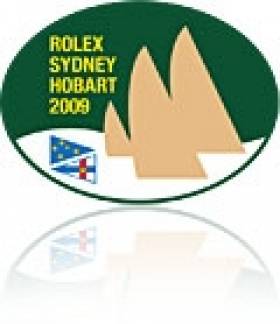Displaying items by tag: W M Nixon
Irish Sailors of This, That & The Other Awards
#sailoroftheyear – W M Nixon reviews the lineup for the Afloat.ie Sailor of the Year 2013 for which voting concludes on February 17th, but only after he has considered some oddities and omissions in the annual circus of local, regional, national and global personal sailing awards. And he makes an important point about the history of Irish sailing awards.
It's a curiosity that in the slew of local, regional, national and international individual sailing awards which have been making it across the finish line as 2013 draws to a close and 2014 washes over us, none seem to have been made to anyone who was sailing in the America's Cup.
Maybe the Cup itself is seen as enough award for anyone. We've said it before, but we'll say it again: The America's Cup is the peak of sailing – alas. Yet this global distribution of gongs to anything and everything except the America's Cup tends to suggest that AC people are seen as functioning in some sort of parallel universe. Or maybe it's a compression chamber. Whatever it is, when a sailor goes into this rarefied zone, he ceases to be seen as a being to whom ordinary matelots can relate in any meaningful way.
The fact that AC crews are de-humanised by being kitted out in black crash helmets and the blackest of black uniforms, and sail on boats to which normal boaty terms scarcely apply (you can't really call it a "she" when it's called a platform in the first place), is all part of the oddity with its alien nature.
And when people are in this extreme world, they have attitudes and speak in ways which are at variance with their approach when they're in another sailing environment. But happily, the good news is that when they emerge from the AC hothouse back into the real world, they soon become as soppy and sentimental as the rest of us.
One of the toughest cookies of all when he's in America's Cup mode is Australia's Iain Murray. It has recently been confirmed that he's moved his focus back home to head up Bob Oatley's Hamilton Island YC America's Cup Challenge, a ferociously demanding role as HIYC are the Challengers of Record for the 35th series.
Thus Murray will have to be up to speed with, and indeed faster than m'learned friends as the legal negotiations get up a head of steam. All that and sailing too. Yet when he's outside the AC bubble, he seems to have attitudes to boats and sailing with which any of us can identify.
One of the joys as 2013 drew to a close was watching the unfolding drama of the Sydney-Hobart Race. There were all sorts of exiting new or totally re-vamped boats, for Australia has been by-passed by the global recession. But the popular money was on Bob Oatley's veteran hundred footer Wild Oats IX, a skinny and much-modified yoke which has had more face-lifts than an ageing Holywood star.
But unlike your Holywood star, the more mods she gets, the more people seem to like the gallant Wild Oats. And among those who frequently sail the big events on her – and whose tactical skill was seen at the start of the Hobart Race in Sydney harbour when Wild Oats carried the much-fancied Perpetual LOYAL (ex Rambler 100) above the crucial break line for the first turning buoy - was Iain Murray. After the race was over and Wild Oats had done the business for line honours yet again, Murray gave his heartfelt thoughts:
"Wild Oats is a bit of an old girl now" he said. "For her to stand up and deliver is special really. This boat and the crew have been around a long time and to keep the boat improving is a nice thing to do.
"I'm sure if you started with a clean sheet of paper now, you wouldn't build this boat, but she's a good all-round boat. She isn't great down-wind or a record breaker or a reaching boat; she is a good all-round boat and coupled with that she has a great, consistent crew that generally gets the most out of her.
"I think everyone in the crew was on their game this year. In the nine (Sydney-Hobart) races this boat has done, this was by far the best".
Read that out in sonorous tones with a lone violin in the background, and there wouldn't be a dry eye in the house. It's about as far from the coldly clinical approach that is essential to the modern America's Cup as it's possible to be, and the word is that Bob Oatley is himself nominated for a sailor's award on the strength of his commitment to the old Wild Oats and the Hobart Race, not for his growing involvement with the America's Cup.
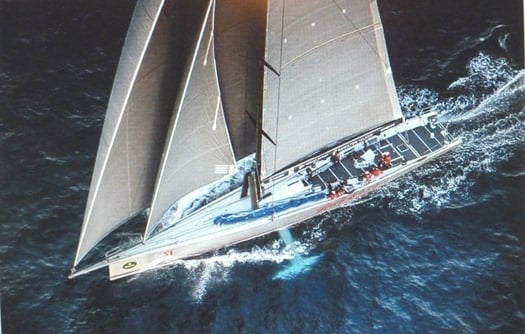
The skinny weird thing which is Wild Oats XI. "If you started with a clean sheet of paper now, you wouldn't build this boat, but she's a good all-round boat".
But while the America's Cup may be enough award in itself, in the bigger picture the variety is such that Sailor of the Month and Sailor of the Year awards are helpful in sensing what's going on, and keeping a record of what has been happening. However, you can soon have enough of a good thing, and too much very quickly. So here at Afloat.ie we're more than somewhat bemused by this week's announcement by the Irish Sailing Association of its up-coming Sailor of the Year award.
There are times admittedly when the ISA do things that make you think they're on another planet. So if they do something that suggests they're in another country, then maybe it's really no big deal. And perhaps we should gracefully accept that this sudden transformation of their Sailing Achievement Award of a year ago into a full-blown Sailor of the Year award this week is a case of imitation being the sincerest form of flattery.
Whatever, out of respect for the 336 Afloat "Sailors of the Month" and 28 Afloat "Sailors of the Year" who have enhanced our sport since we inaugurated these awards back in 1996, we feel that due acknowledgement of their achievements, plus the facts of history, and the current situation in Irish sailing, means that we should at least stake our claim as prior users of the Irish Sailor of the Year title.
Enough said. Voting on the latest annual batch closes at 6.0pm on Monday February 17th. We're delighted with the response there has been right across the board, even if it hasn't been on the scale of the good old days before one-vote-per-voter electronic limitation was imposed, when one determined skipper voted for himself 3,000 times at the mad height of the Celtic Tiger years. We know who he was, and where he lives......
The lineup reflects the diversity of our sport. As recent online arguments about the reinstatement of the Star in the Olympics have emphasised, the majority of us sail in boats with keels, while beyond that there's a very large number of us who seldom if ever race, yet we love our boats and sailing. However, racing creates its own narrative, so inevitably the racing names push their way to the fore afloat and ashore.
JANUARY
GORDON MAGUIRE
In the first week of January 2013, ex-Pat Gordon Maguire celebrated 53 straight weeks of exceptional achievement in Australian sailing. The 63ft Reichel Pugh sloop Loki, aboard which he was sailing master, was confirmed as overall champion in the Australian Blue Water Points Score, which is based on a season-long seven race series with no discard, concluding with the 628-mile Sydney-Hobart.
While defending champion Loki may have had to concede the overall Hobart Race handicap win at the end of December 2012 to line honours winner Wild Oats XI, she was a very solid second to augment her overall victory a year earlier. As for conceding that one win to Wild Oats, it was the only time throughout the 2012-13 season that Loki had done so, and in the second-longest race of the series, the 384-mile Sydney-Gold Coast Race, Loki had been in top form for a convincing overall win.
Gordon Maguire's four years of growing success with a mixed amateur-professional crew aboard Stephen Ainsworth's Loki spoke volumes for his exceptional talents as a helmsman, his inspiring ability as a leader, and his high qualities as a team member. Added to his record as a champion round the world racer and a winner in many other events, this peak of achievement in January 2013 marked the latest chapter in a remarkable success story for Irish sailing.
FEBRUARY
SIMON & NANCY DE PIETRO
Simon and Nancy de Pietro of Kinsale Yacht Club were the Afloat.ie Sailors of the Month for February after their convincing win in Class 1 in the RORC Caribbean 600 Race. With strong family links to North Cork and Sligo, they fly the burgee of the popular club on the south coast of Ireland for their successful international sailing programme.
Lilla, Class 1 winner in the RORC Caribbbean 600 2013
Although their 76ft Philippe Briand-designed Lilla is a much-loved 20-year-old veteran, the high standard of maintenance which is lavished by this enthusiastic sailing couple on their hard-working charter boat shows itself in the consistency of the boat's racing performance in a competitive programme which is fitted around a regular working life on the Caribbean cruise circuit.
The quiet season in the Caribbean is in the summer, and last year saw Lilla avail of summer's opportunity to come north in June and race in the famous biennial Newport-Bermuda Race, which was first sailed in 2006. With Simon as skipper and Nancy as navigator, they won overall in the cruising division. Lilla clearly likes racing to Bermuda, as she has also won overall in another contest to the "onion patch", the annual race from Marion in Massachusetts.
For the start of 2013, Lilla's charter programme was put on hold for a while as she geared up for the new sunshine classic, the RORC Caribbean 600. Although she has relatively shallow draft in order to maximize her cruising choices, she is raced so skillfully that the expected limitations on her windward performance simply don't seem to materialize.
MARCH
FERGUS & KAY QUINLAN
Fergus and Kay Quinlan's three year voyage around the world in their own-built 12m steel cutter Pylades was an inspiration to Ireland's sailing community. And it received international acclamation from the premier global voyaging organisation, the Ocean Cruising Club, which gave the County Clare couple – who sail from Kinvara on Galway Bay – the special OCC Award for those "who have done most to foster and encourage ocean cruising in small craft and the practice of seamanship and navigation in all branches".
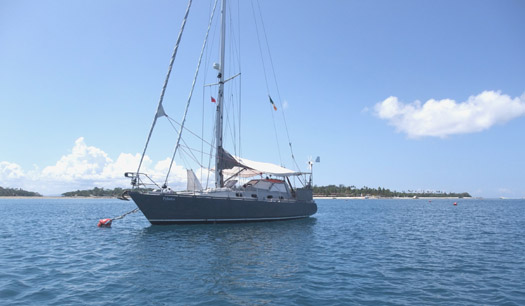
Living the dream. Fergus & Kay Quinlan's Pylades resting in Fiji. Photo: Fergus Quinlan
The magical cruise of the Pylades had already been awarded the Irish Cruising Club's senior trophy, the Faulkner Cup (which dates from 1931), for an unprecedented three years in a row. And for the many in Ireland who had been following the cruise, it came as no surprise that the experienced adjudicators in the Ocean Cr C also found the cruise of the Quinlans to be both an informative entertainment, and a realistic encouragement to those who would hope to do something similar.
APRIL
ROBERT O'LEARY
The O'Learys of Crosshaven have taken the Sailor of the Month title several times over the years with the remarkable achievements of father Anthony, and sons Peter and Nicholas. But the Spring of 2013 clearly demonstrated that there's a new O'Leary on the stage - younger brother Robert, who played a key role in Irish university sailing through March and April.
Previously in the baby brother position as the successful skipper of the family's "cruiserfied" 1720 Antix Beg, young O'Leary made the scene in that hotbed of college development, the University of Limerick. This admired institution's success does more to change public perceptions of the sometimes troubled Shannonside city than a whole raft of government inner city initiatives. But even so, when UL came into being in 1989, it would have aroused incredulity to suggest that, by 2013, it would be the clear pace-setter in the highly competitive and long established world of Irish college sailing.

Robert O'Leary after winning the College J/80 Selection Series. Photo: W M Nixon
Yet such is the case. And what a pace they've been setting. Despite the coldest Irish spring in years, it was the Limerick college sailors who kicked the new season into action by hosting the three day Intervarsity Team Racing National Opens over the St Patrick's weekend in March. Run in Kerry in conjunction with the hospitable Tralee Bay SC, and sailed in Fireflies, the series attracted 26 teams. The logistical demands were such that Robert O'Leary stayed ashore as overall event manager, but UL was on a roll and they won the main title too, captained by Ross Murray.
Then in April O'Leary was very much afloat, skippering the UL crew in the Student Yachting Worlds Irish selection trials raced over three successive Saturdays in April in the ISA SailFleet J/80s, currently based in Howth. The format was demanding, as it involved getting your crew on site three times over a two week period, and then coping with very different conditions on three separate occasions. Yet UL won it in style .
Annalise Murphy (23) of Dun Laoghaire was runaway winner of the Afloat.ie "Sailor of the Month" title for May 2013 after her unprecedented tally of two Gold Medals in the month's top international events in Europe.
The venues could have not been more different. The Murphy run of success started at Lake Garda in Italy, racing among the mountains in the Italian Olympic Week 2013, a challenging event in which the Irish helm emerged supreme with just 2 points to the 5 points of next-in-line Tuula Tenkanen of Finland, and Tina Mihelic of Croatia.
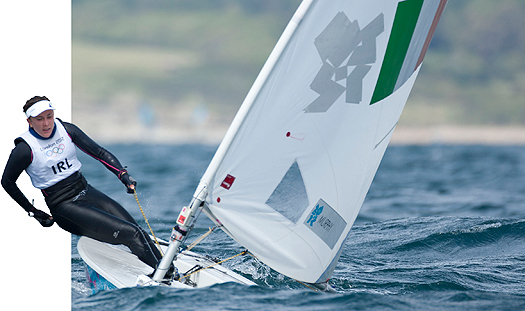
Annalise Murphy's race winning form from Weymouth continued in 2013
The competition became even more intense two weeks later in the wide open spaces at Medemblik in The Netherlands for the Delta Lloyd Regatta. The Dutch weather was still giving a fair impression of winter, and the fleet included Olympic Gold Medallist Lijia Xu of China, and Silver Medallist Marit Bouwemester of the host nation.
Ireland's sailor went into the final medal race in third place, two points behind Alison Young (GBR) and Bouwemester. But in a complete reversal of the form shown in the final race of the Olympics in August 2012, it was Murphy who came confidently powering through to win by more than a minute and take the Gold, while China's star Olympic performer had to be content with sixth overall.
JUNE
BRIAN O'SULLIVAN
Brian O'Sullivan of Tralee Bay was the Afloat.ie "Sailor of the Month" for June following his clear overall win by more than an hour and forty minutes in the biennial 280-mile Dun Laoghaire to Dingle Race between June 7th and 10th.
It was an outstanding month for Irish sailing achievements at home and abroad. But there was something specially heartening in these difficult times about a skipper from one of our most westerly clubs buying up a 33-year-old cruiser-racer, and showing that with a keen crew, and the right conditions, you can still take on Ireland's best and win.

Brian O'Sullivan's Amazing Grace had a stellar Dun Laoghaire to Dingle Race. Photo: Michael Chester
As anyone who followed the ongoing D2D story and subsequent reports on Afloat.ie will be aware, the Oyster 37 Amazing Grace has played an important role in Irish sailing at ports such as Crosshaven, Kinsale and Fenit. Completed by Jim Fagan from a bare hull in a Cork farmyard (though to a standard that belies the tag of "home made"), this classic Holman and Pye design was only bought by Brian O'Sullivan from a fellow member of Tralee Bay SC as recently as the Spring of 2013.
But he knew he was getting a good boat with a decent set of sails. The challenge was to fulfill Amazing Grace's potential with a keen crew who could build up their enthusiasm for the big race from Dun Laoghaire, with Tralee providing a small but keen flotilla in the high quality 22-boat fleet. And when conditions fell their way through the race, they were keyed up to finish in the small hours of Monday morning, right in line for a great Kerry victory.
The crewing team on Amazing Grace were Finbarr O'Connell, Fergus Kelliher, Pearse Boyland, Tim Kelliher, Cian O'Donnell, Brendan Culloty and Michael McCormack, while the essential shoreside support and encouragement was provided by Frances Clifford. But ultimately, any successful team needs a capable leader, and aboard Amazing Grace they had that in Brian O'Sullivan, Sailor of the Month for June 2013.
JULY SAILOR OF THE MONTH
LIAM GLYNN
Ballyholme YC teenage helm Liam Glynn was the Afloat.ie "Sailor of the Month" for July after his comprehensive victory in a fleet of 102 boats at the Topper International Worlds at Loctudy in France in an intense week of racing at the Brittany venue from July 22nd to 26th.
Glynn arrived at the championship on top form with Silver already notched at the ISA Youth Nationals earlier in the season. But he showed his quality in depth by turning in an even better performance in France, despite very different conditions. The ISA Championship had been raced on the tide-free freshwater location of Lough Derg, but the Worlds were sailed in notably tidal salt water with often flukey breezes, and a sometimes lumpy sea state which was not always warranted by the wind strength.
Yet despite the huge fleet, the young Belfast Lough sailor put in the sort of consistent performance which is the ideal of any top skipper, senior or junior. His first four races were all top three placings, including two straight wins, which meant that as the series progressed he was building towards a comfortable cushion of 13 points over the next boat as the final day's racing arrived.
As it turned out, his work was done. The final day of racing was lost to calm, and Ireland had a new World Champion.
JULY INTERNATIONAL SAILING AWARD
BRUNO SROKA
From time to time, we honour sailors from other countries who have achieved outstanding success in Irish waters. But never has our International Award been for anything so extraordinary as French kitesurfer Bruno Sroka's 240 nautical miles voyage on Friday July 19th from L'Aber Wrach in northwest Brittany to Cork Harbour.
In a period of mostly light winds, Sroka was favoured by a beam reach 16 knot nor'easter which he carried with him almost all the way across the mouth of the English Channel, past the Isles of Scilly, and on across the Celtic Sea to a rapturous welcome in to Cork, the feat completed within his aimed time scale of 17 hours, the exact time being 16 hours and 37 minutes, an average of 14.45 knots.
The wind was fading as he neared the Irish coast, but there was just enough bite left in it to bring him to Roche's Point at sunset. A professional kitesurfer, he had already conquered the English Channel, and with his longterm ambition of being the first to get to Ireland from France fulfilled, he is now thinking in terms of the ultimate goal – New York to Brest in 2015.
AUGUST
JOHN TWOMEY
The summer of 2013 was the season in which world sailing came to Ireland. In addition to two World Championships, events such as the Volvo Dun Laoghaire Regatta and the Sovereigns Cup at Kinsale brought many sailing visitors to our shores. Then too, being a Rolex Fastnet Race year, 2013 saw a fleet of record-breaking size rounding our most famous rock, an event in which a dozen Irish boats took part.
The events which were staged from Irish ports involved an enormous amount of voluntary effort from our own communities, large and small. And skilled effort at that. Well-meaning willing helpers can be a mixed blessing. But when experienced administrators build up their chosen team of specialists as the allotted time of each major event approaches, the effective administrative machinery - virtually guaranteed when Ireland is hosting a big event - slips smoothly into place.
After such a summer of so much success in event management, there are many volunteers whose efforts deserve to be highlighted. So in making John Twomey of Kinsale the Afloat.ie "Sailor of the Month" for August, we hope that other organisers will realise that we are applauding their efforts too.
But amongst the elite of organisers, John is the crème de la crème.
An active participant himself to Olympic level, his election in November 2012 as President of the International Association For Disabled Sailing was a well-earned indication of the high regard in which he is held in global sailing. And in bringing the Worlds to his home port and ensuring that it was a success which was popular with the general public too, John Twomey played a unique role, deserving of national recognition and celebration.
SEPTEMBER
FINN LYNCH
The adjudicators in the Afloat.ie "Sailor of the Month" award for September were in the happy position of having a proliferation of major achievements to choose from, and they have the bonus of being able to draw on the "Previous Award" clause.
Like everyone else, we agreed that Annalise Murphy's comprehensive sweeping of the board at the Laser Europeans & Worlds at her home club of the National in Dun Laoghaire had been in a league of its own. But we'd already been on the case with the Murphy performance in 2013, as she was SoM in May after taking two gold medals in major European regattas.
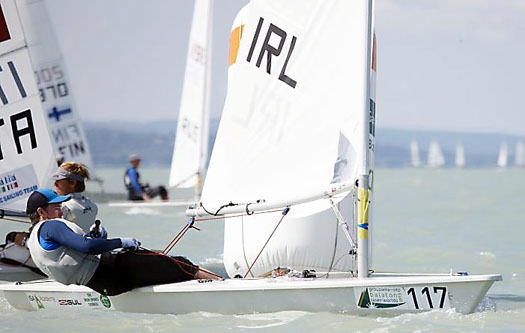
Following a sensational debut in 2012, Finn Lynch consolidated his position as a rising star in 2013.
So with the award for Sailor of the Year 2013 now up for consideration, that May success is rated as a double win. But thanks to this bit of prestidigitation, we still had September's gong to give out, and that went to young Finn Lynch of County Carlow. He also counts the National YC as his home club, even if he did start his sailing at the lakeside club of Blessington up in the Wicklow hills.
When Lynch won the Silver at 2012's ISAF Youth Worlds in Dublin Bay, it was the maturity of the 16-year-old's approach which drew the most favourable comment. And in September 2013, at the ripe old age of 17, he was even more emphatically Irish sailing's Captain Cool. He took Gold in the U21 division, Silver in the Europeans, and Bronze in the Worlds. A phenomenal achievement, and a worthy September Sailor of the Month.
OCTOBER
DAVID KENEFICK
The French sailing scene is noted for its continuing national and international programme of encouraging young sailors in their early twenties into the top level of offshore competition. But even by the demanding Gallic standards of youthful participation against hardened veterans in events like the Figaro Solo, Corkman David Kenefick stood out as youngest of them all. He was just 21 when he qualified to become a Figaro 'rookie' mentored by Marcus Hutchinson, and though he turned 22 during June as the 2013 programme accelerated through a demanding season, he continued as the youngest in a schedule which saw him complete almost 7,000 offshore miles, nearly all of them single-handed.
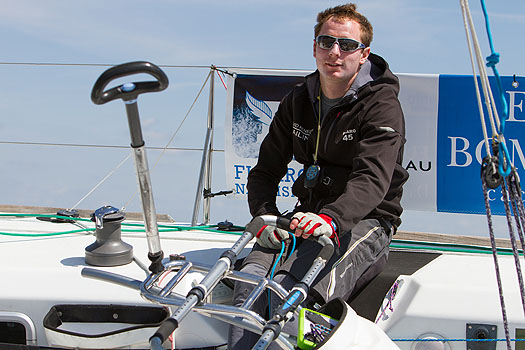
David Kenefick took a mighty leap in the dark with his Figaro involvement, but showed he had the right stuff
As the busy season drew on he also began to acquire a useful smattering of French. And though there were some some big races whose results were eminently forgettable, in October's 1600 mile three stage Generali Solo, the Mediterranean's equivalent of the Figaro Solo itself, he was very much in contention to move towards the coveted "Rookie of the Year" slot.
The Generali Solo reached a climax after its three offshore stages, with three inshore races in perfect yet sometimes quite demanding conditions of 15 to 22 knots of wind. Kenefick's tally of 13,10, and 9th much improved his position on the leaderboard, and he moved into a commanding 12th overall. With the next rookie back in 16th slot, his place was secure, and becoming Figaro Solo Rookie of the Year 2013 made David Kenefick the Afloat.ie Sailor of the Month for October 2013.
NOVEMBER
ADRIAN LEE
For many decades, the Straits of Hormuz were one of those potential flashpoints which could have ignited World War III. In an oil-rich region of extreme political and religious turbulence, this narrow channel connecting the The Gulf with the oceans of the world has been just about the last place you would have thought of routing an offshore race.
Yet there are few things more strongly symbolic of peace than a please boat sailing about her business, even if the business is the cut-throat matter of winning an offshore race. In fact, pleasure boating in all its forms is the essence of peaceful pursuits, something well-recognised by those who promoted the building of the Shannon-Erne Waterways right through the middle of a border area which was suffering grievously throughout Ireland's "Troubles" from 1969 to 1998.
And in offshore racing, these days we think it perfectly normal that Harry Donegan of Cork with his cutter Gull should have been one of the seven entrants in the inaugural Fastnet Race in 1925. Yet that first Fastnet Race was not only staged just three years after the Irish Free State had been established, but its course took the contenders right into the territorial waters of the Rebel County's most rebellious region of West Cork. The presence of the Gull in the race was a powerful gesture of peace and reconciliation.

Adrian Lee's Cookson 50 Lee Overlay Partners sails sweetly and swiftly on her way to winning line honours, the course record, and first overall in the Dubai-Muscat Race
The 360 mile race from Dubai to Muscat in Oman may take place between two states which are receptive to western concepts, but with Iran looming close to the north and Saudi Arabia a huge presence to the south, it's a bizarre enough setting for something so western as modern offshore racing. Yet is has been staged annually for 22 years now, but it is only relatively recently, as the first green shoots of a greater peacefulness spread over the Gulf area, that it has been allowed to achieve the kind of publicity it deserves.
So from being a fleet of local Dubai-based boats which just nipped round the corner to Muscat, it has begun to attract high profile entries to race a course which re-traces part of the ancient spice voyaging routes. But though the local Dubai-based inshore racing sports dhows can reach remarkable speeds, for the demands of a 360 miles offshore in the first weekend of November 2013 it was a tried and tested classic modern offshore racer, the canting-keel Cookson 50 Lee Overlay Partners, which did the business to take a new course record of 2 days 53 minutes and 40 seconds and the overall win, adding them to her overall victory (as Chieftain) in the 2007 Fastnet Race, and her overall win in the inaugural 2009 RORC Caribbean 600 race.
Skipper Adrian Lee hit a happy moment, as his club, the Royal St George YC in Dun Laoghaire, was at precisely the same time celebrating its 175th anniversary by honouring the 597 members who had won major sailing prizes down the years. The Lee victory brought the total up to 598 before the weekend was over. Lee Overlay Partner's crew for the RORC Dubai-Muscat Race 2013 were James Hemingway, Ilya Lee Paveliev, Scott Wilson, Emmet Kerin, James Gunn, Tim Corney, Neil Harrison, Ruairi Herraghty, Robert Witte and Daniel McKeown, and their skipper Adrian Lee very deservedly became the Afloat.ie "sailor of the Month" for November.
DECEMBER
BEN DUNCAN
With a cut-off date at midnight on Christmas Eve, the lineup for Afloat.ie's "Sailor of the Month" title for December provided only three weeks of performance time, but it allowed the adjudicators to spread their net across the entire year's sailing.
And throughout 2013, one sailor was in close contention for the "Sailor of the Month" award more times than anyone else, yet always missed the top title by a hairsbreadth. But when his year-long performance was considered in its entirety, Ireland's resident Kiwi skipper Ben Duncan was in a league of his own. He became Sailor of the Month for December as the sleigh bells started to jingle.
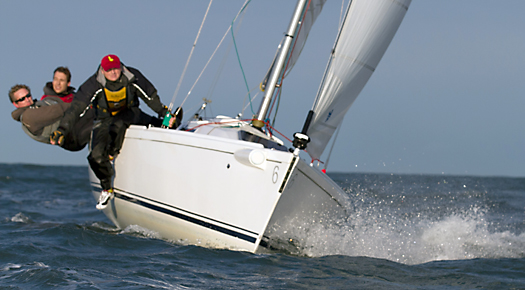
Finishing his season in style. Ben Duncan on his way to winning the All Ireland in a SailFleet J/80. Photo: Aidan Tarbett.
Duncan is best known for his scientific and extremely thorough approach to campaigning his SB20 at home and abroad. He has raised the sailing of these very special boats to a new level. And in October, after a season of success at home and abroad, he was on top of his form to win the concluding championship on Lough Derg.
But the Duncan success path in 2013 didn't end there. The end of October brought a highly specialised challenge to many top helms and Race Officer Neil Murphy. The All Ireland Championship at Howth in the SailFleet J/80s, scheduled as a two day event, had to be put through in just one day's very crisply organised racing as one big storm cleared to the eastward, and another roared in from the west.
To add to the unnerving situation, a weather front with gale force gusts came streaking through at mid-event, requiring everyone to return to the harbour. Yet despite the interruptions, the programme was completed with excellent racing, with sunshine for a bonus. And despite sailing in a boat other than his beloved SB20, Ben Duncan put in the performance of a lifetime for a runaway win to round out a great year.
Cast your vote – Click here to vote for your sailor
Round Ireland Race – Wicklow's Child Outgrows the Family Home
#roundireland – With the announcement that Round Ireland Race organisers Wicklow Sailing Club have taken on Dun Laoghaire's Royal Irish YC as Associate Club for this year's race on June 28th, W M Nixon looks back on 34 years of a pivotal event, and suggests that the new twinned arrangement deserves full support and increased participation.
"Mixed feelings" defines the reaction to the announcement that Wicklow Sailing Club have taken on Dun Laoghaire's Royal Irish Yacht Club as a partner in staging the biennial Round Ireland Race. Until now, even though the largest boats tended to be Dun Laoghaire-based before the event, there's no doubting the real scene of the action was twenty-one miles to the south in a characterful little river port where the unique and very special pre-race atmosphere was charged with emotion and tangible memories of previous stagings of this often epic event.
But in the 34 years since the first race was sailed in 1980, boats have got bigger, and media coverage and tracking of the race have become much more sophisticated. Expectations have been raised. Yet Wicklow Harbour has stayed the same. Indeed, the likelihood is it's going to be even more of the same as the pickup in the economy continues and the number of ships using Wicklow – some of them astonishingly large for the place, and many of them discharging or loading decidedly anti-social cargoes – starts to increase again.
In an age when local trade, exports and jobs are more important than ever, a biennial special-interest sporting event which hopes to transform a busy little commercial port into a yacht harbour of international standard, even for only a few days, is going to receive decidedly mixed messages both from the neighbourhood community, and from those who hope to take part in the race.
With proper recreational boat berthing facilities close to the south in Arklow, and northwards at both Dun Laoghaire and now Greystones, the fact that berthing for anything more than a small handful of visiting boats is inadequate in Wicklow by international standards becomes a bigger drawback with every staging of a race which is at the very heart of Irish sailing.
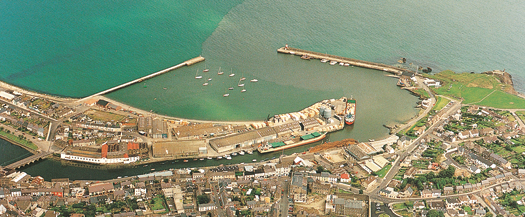
Wicklow Harbour in the summertime, with two substantial ships in port, and visiting yachts rafted up at the outer pier. Photo by Kevin Dwyer courtesy of Irish Cruising Club.
In fact, it was when the peak turnout of 53 boats was achieved twenty years ago that it was clear something needed to be done if the race's growing international stature was going to be maintained. But in 1994, the improvement of facilities in other ports was still at an early stage, so people accepted that being in over-crowded rafted-up berthing in a commercial port setting was part of the Wicklow Round Ireland Race thing.
And of course, the ultimate Wicklow Round Ireland thing was the very fact that a little local sailing club, thanks to one or two key enthusiasts and visionaries supported by loyal teams of clubmates, had been able to pull off the audacious coup of making a non-stop round Ireland race happen, and keep it happening, and successfully too, by making its existence the core tenet of their club's existence.
Other bigger clubs and sailing organisations had made noises about staging a round Ireland race in times past, and there'd been an early three-stage circuit from Ballyholme in 1975. But it was a once off. Yet when Michael Jones of Wicklow announced that his club would be running the first non-stop Round Ireland Race in June 1980, and that come hell or high water they'd stage it biennially thereafter, his sheer determination, and the fact that Wicklow is a significant distance from the then-hidebound Dublin Bay sailing establishment, meant that offshore racing folk with a bit of the rebel in their makeup leapt at the chance to do something completely new.
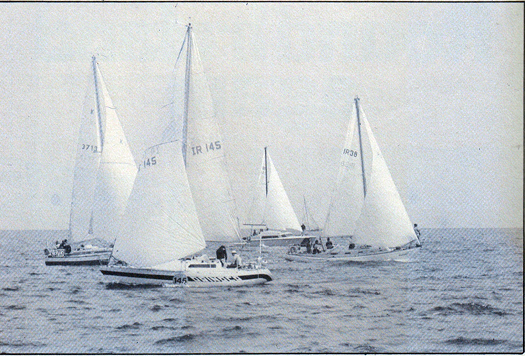
Pre-start manoeuvring at the first Round Ireland at Wicklow, June 28th 1980. Boats are (left to right) the High Tension 36 Force Tension, Shamrock Orinoco, catamaran Snowball, and the Rival 34 Raasay of Melfort.
The challenge attracted thirteen starters from many parts of Ireland, including two round Ireland junkies who had already done that first three-stage race from Ballyholme in 1975. They were Jim Poole from Dun Laoghaire, who'd come second in 1975 with his Ruffian 23, but now had the Ron Holland Nicholson Half Tonner Feanor, and Brian Coad from Waterford, who'd done the first race "in his own good time" with a Folkboat, but now was skippering the Rival 34 Raasay of Melfort, very much a cruising boat but she was to become a round Ireland regular.
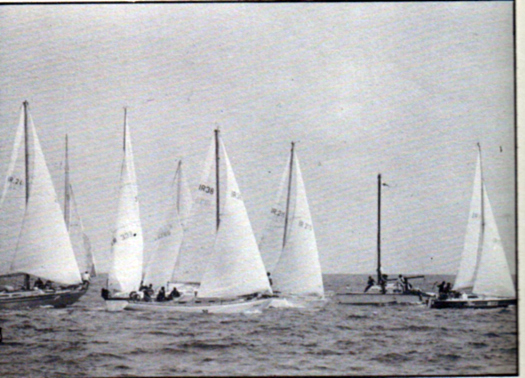
The start. High Tension is already on her way, Brian Murphy's Crazy Jane leads the next bunch from Tony Farrelly's Crystal Clear, Brian Coad's Raasay, and Dave Fitzgerald's Partizan, with Feanor trying to get the right side of the Committee Boat as the tie pushes her south.
The best of a cautious start on Saturday June 28th 1980, in a sluicing ebb and a light to moderate east nor'east breeze, was made by the de Ridder-designed 36ft High Tension-class One Tonner Force Tension, skippered by serial offshore racer Johnny Morris, the boatyard owner from Pwllheli in North Wales. Next across was persistent boat-modifier Brian Murphy from Howth with his own-built David Thomas-designed 28ft Hydro, a boat which was almost permanently in a state of Work in Progress, and eventually became a 31-footer with a needle mast which her ingenious owner was to assemble from bits of scrapped Dragon masts.
After that they came in a rush led by the Cavan doctor-entrepreneur Tony Farrrelly with his Shamrock Crystal Clear (Cavan Crystal was one of his many ventures), closely followed by the Waterford veterinarian Brian Coad with his Rival 34, and then came Galway mining engineer Dave Fitzgerald with his handsome Holman & Pye 41 Partizan, a true cruiser-racer of that era.
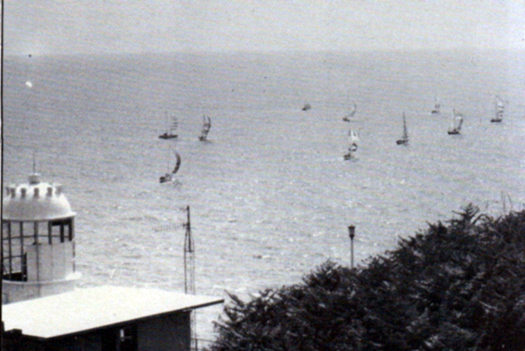
Saturday June 28th 1980, and spinnakers set south of Wicklow Head as the fleet of thirteen boats sets off on the first Round Ireland Race.
They'd a spinnaker broad reach for a while after getting past Wicklow Head, but eventually the wind headed them, and in the lead the Welsh team on Force Tension found themselves hard on the wind for 75% of the course. Down in the body of the fleet, a very determined race was being sailed by Jim Poole with Feanor, his National YC crew including Enda O'Coineen who's originally from Galway, so it was ironic that for much of the race the 30ft Feanor was neck-and-neck with the much larger Galway boat Partizan.
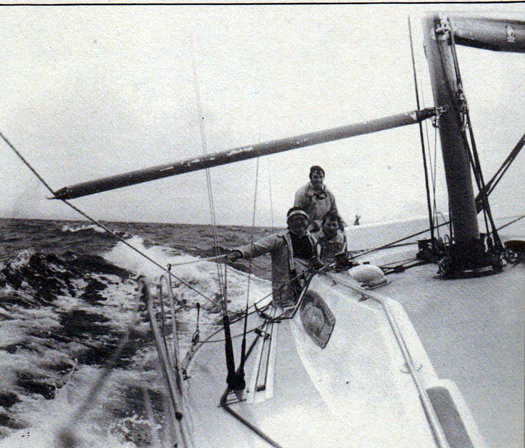
Feanor revelling in fair winds off the west coast during the first Round Ireland Race. Photo: Enda O Coineen

Jim Poole on Feanor off Aranmore in Donegal, neck-and-neck with the larger Partizan. Photo: Enda O Coineen
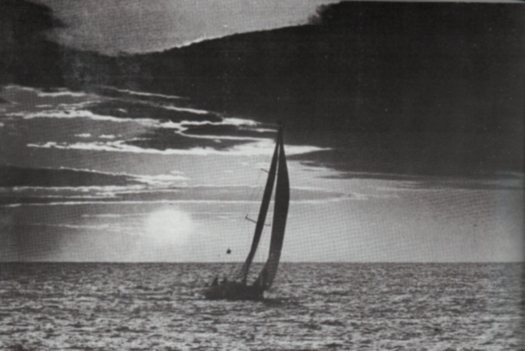
The money shot. Dave Fitzgerald's Partizan from Galway is the first star of the now-traditional image of a boat coming out of the dawn to finish the Round Ireland Race at Wicklow
Force Tension came to the finish in the small hours of the Saturday morning after 5 days 15 hours 2 minutes and 21 seconds, a very leisurely time by today's standards. Partizan was next in two hours later, and as the dawn was breaking the Galway crew were first ever to star in that classic Wicklow photo of a round Ireland finisher coming in with the sunrise. Feanor was in only two hours later, and immediately corrected in to a formidable lead on IOR which she held despite the conditions now favouring slightly lower-rated fast-reaching boats such as the Hustler 35 Red Velvet (Dermod Ryan, RStGYC).
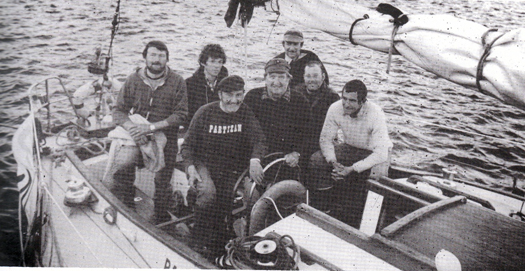
Dave Fitzgerald (fourth right) and his crew aboard Partizan in the early morning in Wicklow shortly after finishing the first round Ireland Race. Partizan competed a number of times during the 1980s, and usually had a bet on with Patrick Jameson's similarly-sized Swan 40 Finndabar.
However, being the first time round, Wicklow SC also had their own handicap system as they'd to include one multi-hull entry, the catamaran Snowball. Under this "Race Handicap", the winner was Brian Coad's Raasay of Melfort, despite the fact that this very comfortable boat didn't get in until the Sunday.

History is made. The first set of published results of the first Wicklow Round Ireland Race 1980
With a retiral rate of only 20% - which reflected very well on Wicklow SC's pre-race qualifying and scrutineering process – the Round Ireland seedling had been properly planted, but now it needed encouragement and nurturing. That came big time with the next race in 1982, when Denis Doyle from Cork turned up with his 1981 Crosshaven-built Frers 51 Moonduster, and his involvement encouraged other noted larger international contenders such as Ciaran Foley's Storm Bird. But while other skippers came and went, The Doyler gave his whole-hearted support to the Wicklow Round Ireland Race for many years, and he was an example to everyone else, as he and his hugely-supportive wife Mary stayed in a B&B near the harbour for the pre-race days, and at every turn ensured that the race team in WSC got the encouragement and credit they deserved.
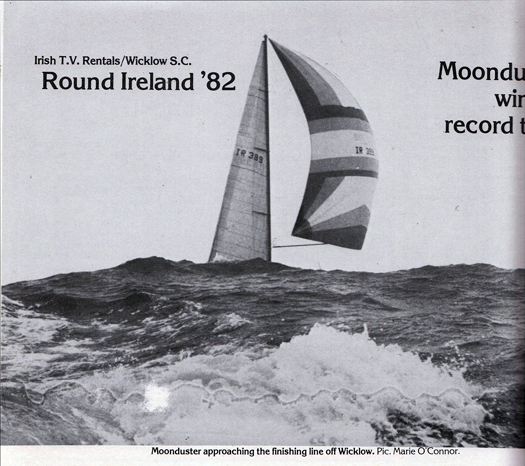
Moonduster comes to the finish line in 1982 in a brisk nor'easter – a scan from Afloat magazine August 1982.
Moonduster in turn put in stellar performances which gave the event its proper glamour. In 1982 she set a good course record despite a nor'east gale giving the leaders a right pasting along Ireland's north coast. But it was 1984 when she sailed the definitive round Ireland record race in fresh to strong west to nor'west winds which curved at just the right time to enable the big varnished sloop to fly. "We saw off an entire Irish county in every watch" was how navigator John Bourke (later the Commodore of the RORC) was to put it after the finish.
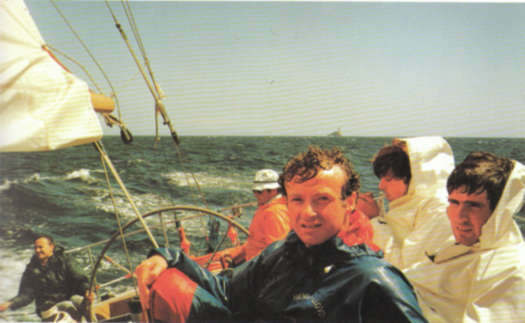
The Fastnet astern, and it still only Sunday.......a carnival atmosphere aboard Moonduster as she shapes her course for Mizen Head in 1984's record-setting race, with Neil Hegarty to lee on the helm, Brendan Fogarty and Grattan Roberts in foreround, and is that Donal McClement behind them?
Moonduster's 1984 record of 3 days 16 hours 15 minutes and 43 seconds was a prodigious time for a mono-hull sailing a circuit course at a pre-ordained time, its quality underlined by the fact that it took a 60ft catamaran – Robin Knox Johnston's British Airways – to shave a bit off it in May 1986 with a designated own-time-choosing challenge. As for mono-hulls in the Round Ireland, it wasn't until Colm Barrington came along with the Volvo 65 Jeep Cherokee that The Duster's time was bettered, and it took a hundred footer to better it yet again with the current record set by Mike Slade's Leopard – helms including Gordon Maguire - in 2008.
But while records by superstars captured the headlines, for the vast majority of sailors the Wicklow Round Ireland Race really has been a matter of taking part personally while doing the best you can. And in its thirty-four years, the event has built up an extraordinary mythology in which the unique and sometimes maddening situation in Wicklow's crowded river has been seen as part of the mix.
But recent years have also seen a real game changer with the Round Ireland Race becoming recognised as part of the RORC Championship, up there with the Fastnet and the Middle Sea Race in terms of points loading.
In times past, every time a big boat was brought in by a sponsored crew, they simply had to be based in Dun Laoghaire, as Wicklow hadn't the space to accommodate them in fully-sheltered berthing, while the business of getting sponsor's guests anywhere near the boat was an unattractive proposition from an old-fashioned and crowded pier.
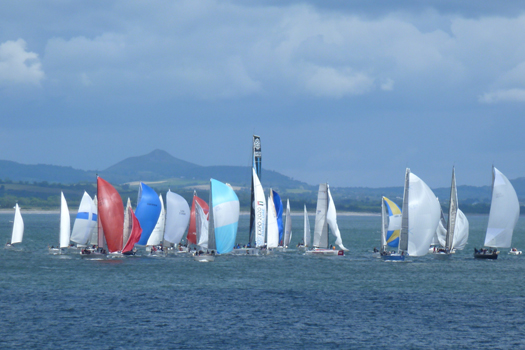
The start of the Round Ireland Race has become something special. This is 2012's race with the Wicklow scenery briefly in some sunshine in a very poor summer. Photo: W M Nixon
Oddly enough, though, the economic recession continued to preserve the old way of having things essentially based around Wicklow, with Dun Laoghaire only as an add-on. There simply haven't been the big money sponsored large yachts taking part, while the hyper-keen entries from the main body of the international RORC fleet, such as Piet Vroon's Tonnere de Breskens from The Netherlands and the Gouy family's Inis Mor from France (and Clifden!) were so keen to race, and so understanding of local enthusiasm, that they happily went along with the traditional setup.
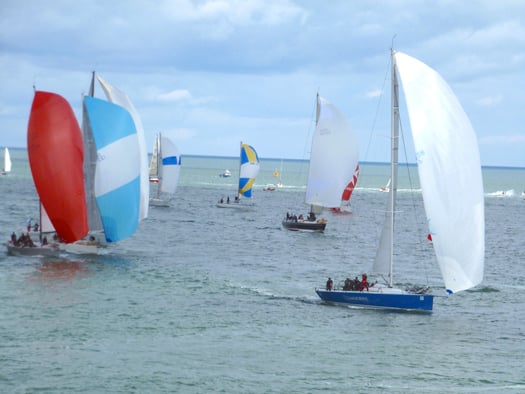
Closing in for the gybe under the cliffs south of Wicklow town in 2012, round Ireland racers include two contenders in the RORC Championship, the Ker 39 Inis Mor (red gennaker) and the blue-hulled Tonnere de Breskens. Photo: W M Nixon
However, the economy is on the move again, and it's reckoned interest in the Round Ireland Race could blossom much more rapidly and strongly if the RORC support could be backed by the provision of pre-race berthing facilities which approach international standard. But set against that, after so many successful stagings of the race, Wicklow SC's Round Ireland Race experience and database is unrivalled, while the club's commitment to its town and quaint little port is total.
Whether the connection to the Royal Irish YC in Dun Laoghaire in the linkup's proposed form is the longterm solution remains to be seen. But if the sheer goodwill which permeated the reception in the RIYC announcing the partnership is anything to go by, then it will work.
And there's no doubt the Royal Irish has the ideal setup for show-casing high profile entries before the race in the sort of scenario top-end sponsors dream about. Yet it's ironic, as it it's all a case of Blessed are the Grumblers, for They Shall Inherit the Earth. It's largely forgotten now, but when Dun Laoghaire Marina was finally installed to become an overnight success after 25 years of struggling by its proponents, some of the most formidable opposition had come from a very old Old Guard within the RIYC membership, largely among the pavilion membership who liked to enjoy the view of boats bobbing about on moorings as they enjoyed their leisurely lunch.
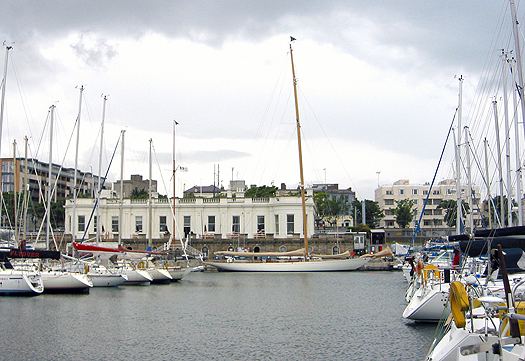
The Royal Irish YC provides the unbeatable combination of an historic clubhouse beside a modern marina. It's ideal for showcasing boats, as demonstrated here by the 70ft classic Hallowe'en, which was line honours winner in the 1926 Fastnet Race. Photo: W M Nixon
Yet now, here is the historic clubhouse with a world standard marina to which they even have their own private secured access. In your wildest dreams, you couldn't have visualised a better setup for allying modern facilities with a traditional clubhouse totally imbued with Irish and international sailing history at the highest level.
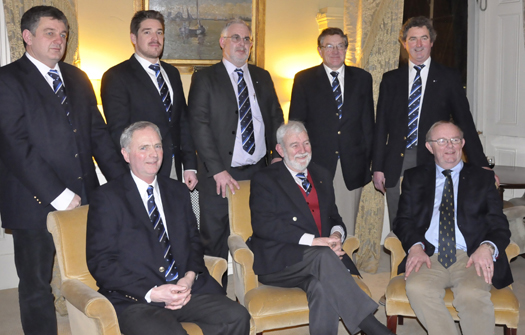
At the reception for Wicklow SC's Round Ireland partnership with the Royal Irish YC in the RIYC clubhouse were (left to right, back row) David Ryan, Kevin Johnson, John Harte and John Johnson (all WSC Round Ireland committee), and front row Peter Shearer (WSC Commodore), Theo Phelan (Round Ireland Race organiser) and Paddy McSwiney (RIYC Commodore).
So in choosing the RIYC s their race partner, and in planning to set up an auxiliary race office within the RIYC clubhouse while retaining the start and finish line at Wicklow, the Wicklow SC people have chosen well. In its three decades-plus history, the Round Ireland Race has had only four organising secretaries – Michael Jones, Fergus O'Conchobhair, Denis Noonan and now Theo Phelan. It is the latter who is powering the Dun Laoghaire linkup, and it moves the Round Ireland Race onto a higher plane of development potential, aiming at a hundred entries by 2016, with this year's race on Saturday June 28th seen as the first step in a new stage of the journey.
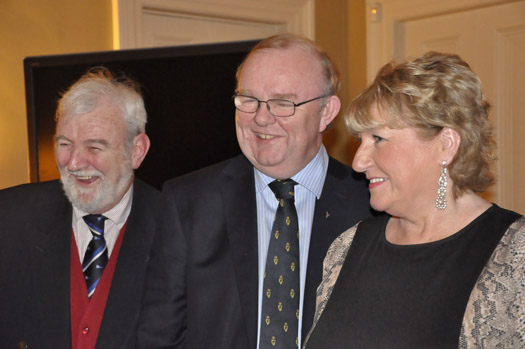
Theo Phelan, David McSwiney and Sadie Phelan, President Wicklow SC
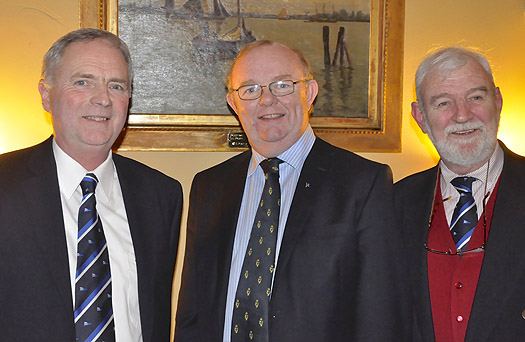
Peter Shearer, David McSwiney and Theo Phelan at the Round Ireland reception in the Royal Irish YC.
It is up to the rest of the Irish sailing community to support them, and to take part if at all possible. In fact, dare we say it, but you aren't really a proper Irish sailor unless you've at least started one Round Ireland Race, and having a few in your CV is good for the soul.
Do it, and you'll find you care very much indeed that the Round Ireland Race should continue to grow and prosper. Those of us with Round Ireland experience will know only too well what a tricky path it is that the organisers have now set themselves. Let them be encouraged by knowing that, while our heads may be in Dun Laoghaire, our hearts are in Wicklow.
Has Dun Laoghaire Lost the Plot?
#dlharbour – Dun Laoghaire's waterfront area and harbour is a hotbed of development and proposed projects. W M Nixon takes an outsider's view of what might be happening around Ireland's biggest sailing centre.
Your heart would go out to Dun Laoghaire. The perceptions which emerge from proposals for developments and new businesses along the waterfront definitely don't chime at all with the image of a place which once was known as Kingstown, and has its origins in the heights of gentility and middle class refinement.
What are we folk from other ports to make of it all? We find sailing in through the entrance to savour Dun Laoghaire harbour's unique style a wonderful experience. There is nowhere quite like it, not just in Ireland, but anywhere else in the world. Yet rumours fly around about changes which could seriously impair the special character of the place. What are those of us who may not have the inside track on the true nature of actual and anticipated developments along the waterfront to make of it all?
Not to pull the punches, it seems that the Dun Laoghaire waterfront area is going to have an enlarged halting site for the Travelling community down towards the west pier. It's going to have an "urban beach" resort amenity for the sort of people who use such places within the harbour on the inner end of the east pier, thereby blocking off a very useful berthing space. And it's going to have the Dublin area's first Wetherspoon's super-pub right bang in the middle of the harbourside.
Set against Dun Laoghaire history and the elegant appearance of its better buildings, this would all seem bad enough. But that is to ignore the most enormous elephant in the room. This is the new public library, which has been put up with astonishing speed to block out much of the sea view from the Royal Marine Hotel. It towers over the entire waterfront with a prow which suggests that at last Ireland has her first aircraft carrier. But unfortunately for any strategic purposes and rapid peace-keeping in distant parts of the world, it happens to be very landbound in the midst of mostly pleasant smaller buildings which now seem utterly dwarfed.

It's behind you!!!........ The new Dun Laoghaire library looms over everything on the waterfront. Yet if you're in the National YC (foreground) and looking out to sea, you don't know it's there. Photo: W M Nixon
It would indeed be wonderful if it were an aircraft carrier and could put to sea and leave the town to nurture something of its own true character. But instead we have to learn to live with it while wondering what it's all about, though in fairness it should be mentioned that the first notions of it were to provide a structure to match the sky-scraping Daniel Liebeskind building (remember that?) which once upon a time was planned for the Carlisle Pier just across the way.
But if this is indeed a public library, then we can only conclude that the good people of Dun Laoghaire must do an awful lot of reading, for it's HUGE. And we can only fear that if they read with the assiduity this building suggests, then they'll have neither time nor energy for anything else, not even the seagoing pursuits which the possession of one of the finest artificial harbours in the world should encourage.
From Dun Laoghaire's traditional promenading area of the East Pier, the new library building towers in particular over the National Yacht Club. Of course, if you're in that most hospitable club and looking out to sea, you're blissfully unaware of this enormous presence behind you. But the effect on people coming in from seaward is distinctly oppressive - it's like that giant black space craft which hovered over New York in the movie Independence Day.

Dun Laoghaire in the rare ould times, when you'd a real sea view from the Royal Marine Hotel, and from the pier could admire that splendid establishment in all its glory. Photo courtesy NYC.
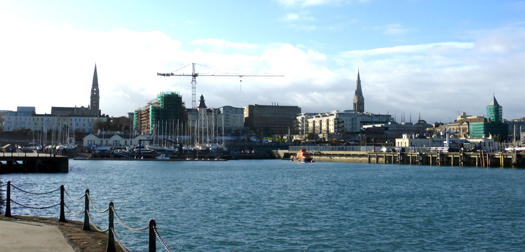
The same section of waterfront today. Is this progress? Photo: W M Nixon
Until this thing appeared, there were still some relics of ould decency and architectural harmony along the Dun Laoghaire waterfront and the streets immediately behind it. Any significant building is a statement in itself, so we're entitled to look at buildings as they are, and respond to them. The central gem of the waterfront is the railway station, designed by John Skipton Mulvany. It's a perfect little jewel of neo-classical design, and to my mind makes a much pleasanter architectural statement than that other exercise in classical work, the Casino at Marino, which was fussily built as an architectural exercise, whereas Dun Laoghaire station is both functional and beautiful, well fulfilling its contemporary role as a stylish restaurant.
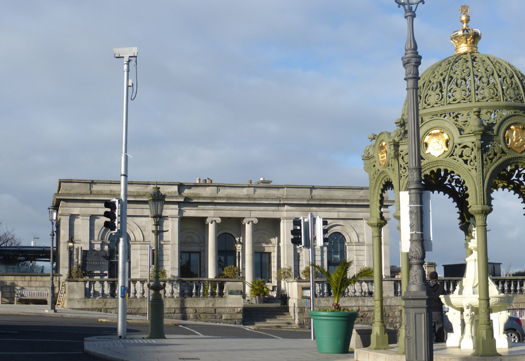
Dun Laoghaire's Mulvany-designed station is a gem. Photo: W M Nixon
Dun Laoghaire did very well out of John Skipton Mulvany, as in 1851 he created the design for the Royal Irish Yacht Club building. In terms of Irish history, few buildings are so significant in the very fact and timing of their construction. Originally founded in 1831, the Royal Irish had been overshadowed by its brasher younger sister, the Royal St George YC founded 1838. While the George developed rapidly as the exclusive preserve of the land-owning classes and the most prosperous Protestant business magnates – the offspring of Cromwellian land-grabbers and the Jamesons and Guinnesses, in other words – the RIYC, as a club with some of the older traditions in its makeup, went into a decline which was accelerated by the grievous effects of the Great Famine from 1845 onwards.
Thus when a meeting of several RIYC members – their numbers including Daniel O'Connell the Liberator - was held in a Dublin hotel on 4th July 1846 (American Independence Day by design, one presumes), it was in the hope that the club could be revived as an expression of faith in the future, and they agreed that a new landmark building on the waterfront would be the key to this.
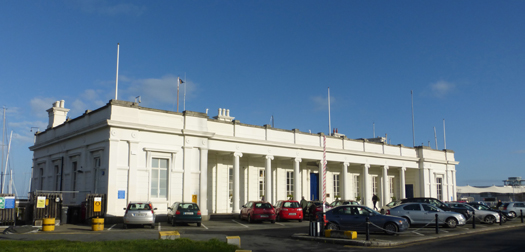
The landward side of the Royal Irish YC. With the undeveloped nature of the waterfront, the architect had to design a building which presented a proper facade on all fronts. Photo W M Nixon
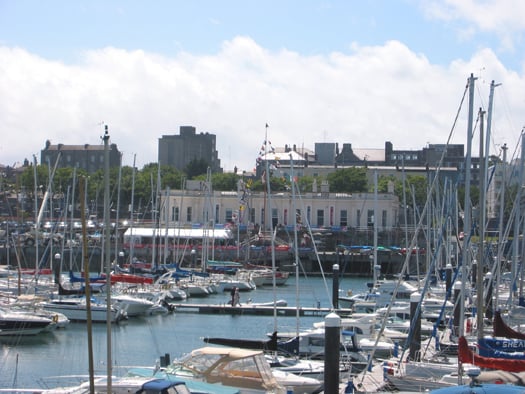
The Royal Irish YC seen across the marina. Built 1851, it is the world's oldest complete purpose-designed yacht club building. Photo: W M Nixon
So in responding to the RIYC's impressive neo-classical pavilion on the harbour, we are looking at both the world's first complete purpose-built yacht club house, and the very symbol of a nation beginning the long road to recovery from both the Famine and centuries of conquest and despoliation.
Along the waterfront, the Royal St George clubhouse by contrast was built through frequent expansions, but as Mulvany was also involved in some of the stages, it has a fine sense of completeness despite its several creators in different eras. Facing up to the challenge of matching these two classical buildings on the waterfront to the west was clearly an insuperable task, so when the National Yacht Club came into being as the Edward Yacht Club in 1870, it went for a much more under-stated architectural style. There's something attractively of the shooting and fishing lodge of the west of Ireland about it, it seems modest by comparison with the other two clubhouses, yet it's surprisingly roomy and stylish within.

Although it was built in several stages, today the Royal St George YC presents a complete appearance, and it preserves its sense of identity despite the encroachment of much taller modern buildings nearby. Photo: David O'Brien
All three of the big waterfront clubhouses are immaculately maintained and each brings its own injection of vitality – and substantial employment – to Dun Laoghaire. And the town in turn has developed in concert with the growth of maritime activity, and the increased communication with Dublin brought about by the historic railway (which was opened in 1834) and frequent road improvements, while summertime excursion steamers sailed to the harbour from Dublin port.
Some would compare the stylish seaside town for Dublin which tried to develop at Dun Laoghaire with Brighton in its relationship with London. But Brighton was purely a seaside resort in which the recent marina is an add-on, it's not a harbour which is central to the place. Dun Laoghaire by contrast is all about the harbour. There was virtually nothing there until this vast asylum and ferry harbour for large vessels (that was its sole original purpose) was built on a totally empty bit of coastline eastward of the old Dunleary harbour, a shallow tidal inlet which it enclosed and whose existence is remembered in the area's local name The Gut.
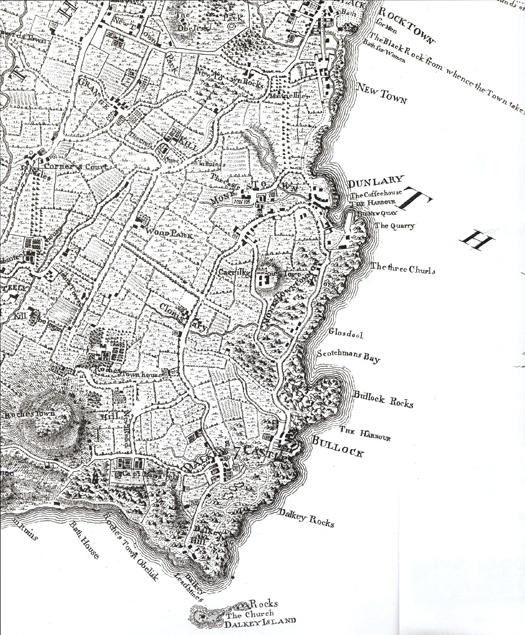
The coast at Dun Laoghaire before the harbour was built. The harbour of Old Dunleary, in the area still known as The Gut, was a shallow creek in the southwest corner of the new harbour.

First plan for the new harbour in 1817. The entrance was made wider in the finished version, and the West Pier was built further west to enclose the Old Dunleary harbour
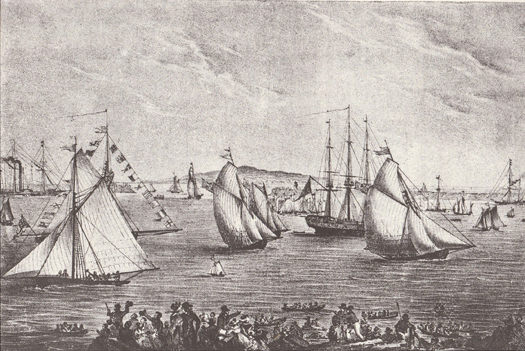
The first regatta in the new harbour was sailed on July 22nd 1828, and was won by Liberty (on right, 39 tons, owner Lord Errol) from Medora (45 tons, owner Mr Kelly). The Royal Irish YC emerged in 1831 from this event.

The yachtsman's Dun Laoghaire today, as shown in the ICC Sailing Directions. Courtesy Irish Cruising Club
Thus it may be stretching it a bit, but the most telling comparison for Dun Laoghaire's aspirations might well be Trieste on the Adriatic. In the glory days of the Austro-Hungarian Empire, Trieste was Vienna-on-Sea. The distance from the capital may have been enormous by comparison with the short hop from Dublin out to Dun Laoghaire. But Emperors – even ancient Hapsburg ones – could move mountains and shorten apparent distance, and they could ensure that the distance to Trieste was no barrier to the place having a Viennese atmosphere, style and sense of place.
Those who find such an idea crazy might like to remember that your man Von Trapp, he of Sound of Music fame, was in real life an officer in the post–imperial Austrian Navy. Trieste was for real. So in a sense if we wanted to see what Dun Laoghaire in its burgeoning Kingstown days was trying to become, just think of it as Official & Ceremonial Dublin-on-Sea. Thus the buildings tried to be slightly miniaturised versions of impressive buildings of government in the city itself, and for a while they succeeded.

The Town Hall gets the attention it deserves. Photo: W M Nixon
The Town Hall, for instance, is a delight – to me it speaks as a restrained exercise in Italianate Victorian, and were it facing onto a proper town square, we really would have a space to celebrate. And just along from it in the town in its glory days was the unsullied façade of the Royal Marine Hotel. French chateau, I would say, and all the better for it. But another enjoyer of architecture was suggesting the other night that there was more than a hint of the south German schloss in it, so we agreed that it was either French or German depending on which country had won the most recent little war over Alsace and Lorraine.
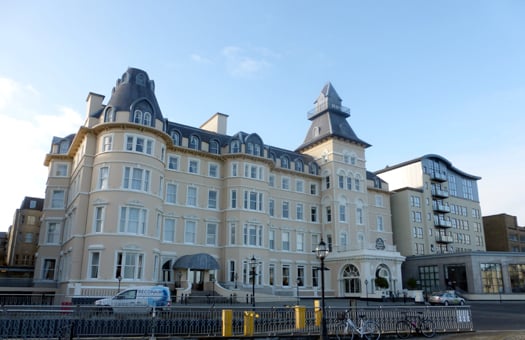
The Royal Marine Hotel has a distinctive style which unfortunately was not replicated in the extension on the right, which was added several decades ago. Photo: W M Nixon
Whatever, the Dun Laoghaire waterfront at the height of the late Victorian-Edwardian era really was quite something. There were several different styles of architecture, but mostly they were good examples of their type, and all respected each other. It had a sense of completeness which harmonised with the harbour. But since then we seem to have lost the plot. Is there an element of disliking the built symbols of the past, and therefore sticking up something which is effectively a deliberate affront?
Perhaps it's just that architects are scared stiff of being accused of producing new buildings, or extensions to buildings, which are merely pastiches of what went before, despite the fact that the general public seem more than happy with a good pastiche. And surely it's better to have a good pastiche than a bad bit of pseudo-modern design which clashes with everything about it?
Thus the harmonious Dun Laoghaire waterfront of a century ago, as seen from within the harbour or down the piers, is now giving out conflicting messages which dampen the sense of welcome for those entering the port. The stately Royal Marine Hotel, a bit pretentious in its day perhaps, but nevertheless true to itself, was given an addition on its western side which, unusually, still hasn't mellowed in – it continues to look like a bad example of architecture from a particularly poor period.
As for that wonderful Town Hall, the office block added down one side is better than the addition to the Royal Marine, but it has lost the opportunity to make a statement of harmony on the building's north side facing across to the railway station. And as for what could have been a town square in front of the Town Hall (for which we argued in favour in several issues of Afloat magazine a very long time ago) that was filled with the Pavilion Development which, while built with quality materials, has never seemed to quite know what it is supposed to be doing. You could scarcely claim it to be a runaway commercial success, and as ever in Dublin, it was the residential part of the project which provided the real motor for the exercise.
But those residential blocks in turn intruded on the vital miniature parkland and garden in front of the Royal Marine Hotel. Now that glorious sea view from the Royal Marine is being further impaired by the new library. In fact, "impaired" is scarcely the word. The Royal Marine doesn't really have a sea view any more at all, in the sense that rooms at the front had a view clear out into the open waters of St George's Channel. Strictly speaking, all that the Royal Marine can now look forward to is a harbour and bay view, which is rather different. Much better than many Dublin hotels, perhaps, but a poor thing by comparison with the wide nautical vistas of the past.

Artists's computerised impression of how the view of the Royal Marine hotel will look once the new library (left) is completed
As for this new library, doubtless in the architectural trade it will be seen as an impressive use of new materials, and it will be pointed out how skilfully it has been fitted into a narrow space. But the computer-generated impressions of the finished building show something a little too like a Belfast peace wall to bring joy to the heart, and on its east side – the hidden side looming over many residential properties – they seem to be utilising rather a lot of nasty red brick, something which is otherwise almost entirely unused anywhere else on the Dun Laoghaire waterfront.
But while the new library may seem to roar at its neighbours and loom threateningly over them, not every new development along the Dun Laoghaire waterfront provokes hostility. For instance, the new Irish lights headquarters is so good of its type that it greatly enhances the area. And as for the Ferry Terminal, "reasonably good of its sort" might be the kindest response. Something had to be provided to give a positive architectural response to the very new-style HSS ferries, and when there's one in port it's sometimes difficult to tell where ship ends and ferry terminal begins, which is as it should be.
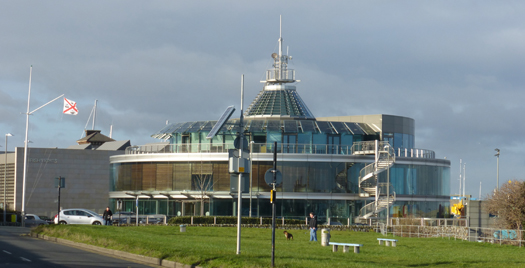
It just shows what you can do by really trying, and being brave. The impressive Irish Lights headquarters building. Photo: W M Nixon
But the era of very high speed ferries may be drawing to a close, as the shipping companies gravitate towards a new generation of ships which may not be so utterly fast, but are much quicker than the boats the HSS replaced, and provide a level of on-board comfort which makes the little extra time aboard slip easily by.
With economy measures now totally dominant, the lower berthing prices and much greater available berthing options offered by Dublin Port offset the fact the driving through the hinterland of the Port to the ferry terminals is not really a joyous urban experience. Most car-ferry passengers are prepared to tolerate a level of urban and sub-industrial blight in order to get cheap fares and frequency of service.
But where the ferries move away as they appear to be doing from Dun Laoghaire, it seems the cruise liners want to move in. The cruise liners currently can berth alongside in Dublin Port, but have to lie off in Dublin Bay if they want to send their passengers directly by tender into Dun Laoghaire. But for the cruise liners and their guests, the prospect of Dun Laoghaire becoming a proper cruise liner port is positively mouth-watering.
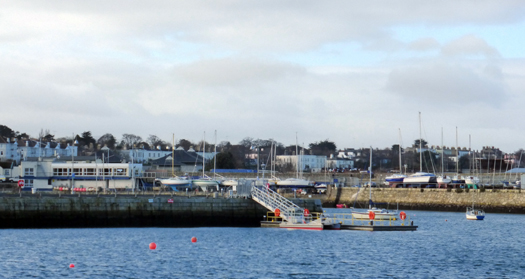
At the moment, the only access the passengers on large cruise liners have to Dun Laoghaire is via the ship's tenders to this landing pontoon in the Inner Harbour. Photo: W M Nixon
For when it fulfils its potential, Dun Laoghaire is a place of style and fun, an ideal up-market cruise liner destination. Simply being there in a luxurious cruise liner would be enough in itself on a sunny day with the harbour and waterfront alive with people enjoying themselves. And the ready access to Dublin itself, and the Garden of Ireland in Wicklow, is all a bonus.
But such perfection won't come cheap. For sure, if it comes to fruition the Dun Laoghaire Harbour Masterplan of two years ago, indicating a large cruise liner berth to the west of the present ferry terminal, would indeed provide the Harbour Company with a golden source of income. But whether that income can be transferred onwards to traders in the town is another matter.
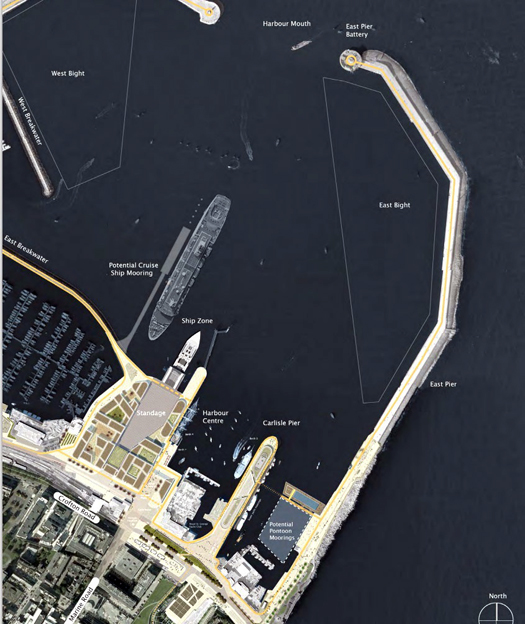
The initial plan of two years ago for a Cruise Liner berth within Dun Laoghaire Harbour. While it will restrict some sailing and boating space within the harboiur, new space will be created by the removal of the moorings in the East Pier bight. Note the proposed swimming pool indicated at the time at right angles to the East Pier off the National YC (bottom right) with marina berths within a new breakwater.
Cruise liner passengers are notorious for seeking complete packages beforehand. Thus when they arrive in port they expect shore visits to be part of the deal, and they prefer to move in pre-paid groups ashore, rather than move individually and spend some money in the town. So those who would expect across-the-board benefit may be disappointed. They may find that the cruise liner seen as the goose that lays the golden does indeed squat down, almost taking over the entire harbour, and it does indeed lay a golden egg. But that golden egg is only a fat berthing fee for the harbour company and hire fees for some bus company. Beyond that, expenditure can very limited.
Yet there's no denying the real money that be made out of berthing fees, and that of course will percolate into the town in the form of wages for extra waterfront staff. Who knows, they may even have to find a crew for a designated Dun Laoghaire harbour tug or two, though a state-of-the-art cruise liner is computer controlled by a single joystick activating thrusters working every which way, and it's amazing the spaces they can access without tugboat aid. That said, in the event of a rare summertime nor'east gale, you could sell tickets for the end of the pier to watch a giant liner getting out.
But this is all way in the future, though with every step in the economic recovery, that future is accelerating in its approach. For the moment, we can be sure that markers are being put down for future harbour use, and the word is that all the swinging moorings in the east bight of the harbour are going to be cleared, presumably to allow eventual manoeuvring space within that part of the harbour for liners. As that space will be empty when no liner is moving, its possible availability will partly compensate for the inevitable loss of sailing and boating space within the harbour, which is a proper concern of Water Wag sailors, inshore rowing clubs, and the increasing number of sailing schools.
A newer line on the grapevine has it that one of the yacht clubs outside the current marina, currently concerned about members losing those mooring in the eastern bight, has negotiated exclusive rights for its members to the stand-alone marina pontoons in the northwest part of the harbour inside the northern marina breakwater, those berths to be accessed by a regular ferry service from the club in question.
While seeing the logic of this, it would put paid to a crazy little notion of mine. Until this new allocation arose, it had seemed to me that there was potential for a completely new club, with its headquarters way down the West Pier where it meets outer marina breakwater. This new club would have its own direct access to that northwest part of the marina. The wild West Pier – which some would like to se as a kind of nature reserve – has ample room for both a roadway to this new clubhouse, and the existing walkway right out to the lighthouse. It would be one of the few clubs in Ireland to be south-facing, and its location would certainly provide that sense of being away from it all which is supposed to be what going sailing is all about.
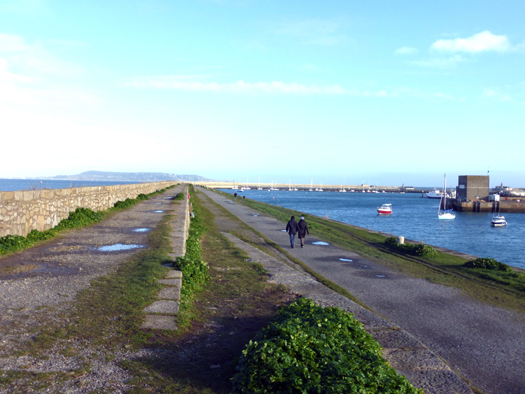
The wild West Pier. Were it needed, there is plenty of space for both a walkway and a roadway. Photo: W M Nixon
But that little daydream is now gone with the likelihood of a rapid ferry service from a club to the northwest Marina pontoons. Meanwhile, back in the real world, what is happening to preserve or destroy Dun Laoghaire's unique ambience which will, it's hoped, encourage Cruise Liner Companies to fork out mega-bucks to berth there?
If you look carefully at the Masterplan, you'll see that in front of the National YC there's a blue pool indicated at right angles to the East Pier. At the time, this was envisaged as a swimming pool and lido area in a vast barge, and it seemed a reasonable idea, as within it there were indicated new marina berths within convenient reach of the club.
But a recent planning application by the Harbour Company has put a different spin on all this. The new "urban beach" will be on a floating structure paralleling the East Pier alongside that handy berthing area on the East Pier. A cost of €2.5 million is being quoted as the capital expenditure needed to create this new facility, and the spokesmen for the harbour company are confident it will attract enough high-paying customers to pay off the initial cost while covering the significant running costs.
That's as may be, but this large intrusion into valuable berthing space is also a matter of concern for those who have been campaigning long and hard for the restoration of the nearby disused Dun Laoghaire Baths, which are outside the harbour area and therefore wouldn't reduce any valuable berthing space. But in any case they're in a deplorable state of dilapidation, a danger and an eyesore, so some action is urgently needed. There's a Public Meeting on today (Saturday January 25th) about all this in the Kingston Hotel in Dun Laoghaire at 3.0pm, and it will be interesting to hear what people think about the old baths in relation to the proposed new urban beach.
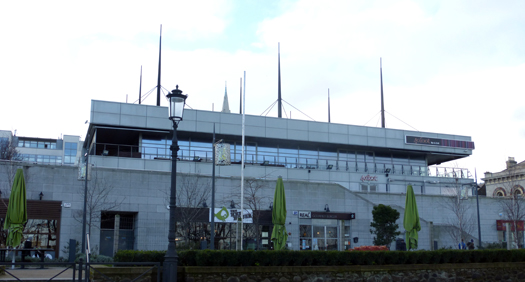
The English pub chain J D Wetherspoon have indicated their intention of opening in the former Forty Foot premises on the top of the Pavilion. Photo: W M Nixon
We move along the waterfront to the Pavilion, and the former Forty Foot pub. It's as near as certain going to be the Dublin area's first J D Wetherspoon pub. You'll have heard of them as the people in England who already have a chain of 900 pubs, and have just opened the first ever pub at motorway service area, which one would have thought unthinkable, but such seems to be the case. Anyway, big chief Tim Martin and his efficient team running this outfit have decided the time is now ripe to move into Ireland with its many post-Tiger era bankrupted bars.
And they make no secret of their intentions. Their ideal location, they say, is large premises in a strongly working class area. Good for them, you say, but who on earth reckons Dun Laoghaire to be a strongly working class area? Well, 900 successful pubs across England can't be wrong. And it could well be what the Pavilion needs to come to life, even if it's not quite what posh passengers on a cruise liner might expect. But as for resentment that an English pub chain is moving into Ireland, the reality is that your favourite local, after a tricky time emerging from the aftermath of the boom years, is now probably owned by a German bank anyway.
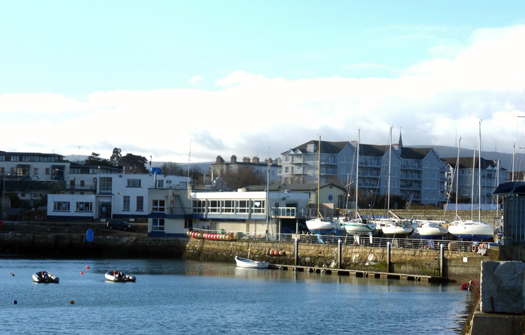
It's one very crowded little spot already. The Dun Laoghaire Motor Yacht Club, the Coastguard, and the Irish National Sailing School are among those crowded into the southwest corner of the harbour where a new Halting Site is also planned. Photo: W M Nixon
Concluding with our third opening point, the proposed new halting site towards the West Pier is a tricky one. That corner of the harbour has a small long-established site, presumably the new one will be much bigger. And things are already very crowded down there with the Dun Laoghaire Motor Yacht Club on the sea side of the little quayside street, and the premises of the Irish National Sailing School, the Irish Coastguard and others across the narrow road.
The business of Traveller Halting Sites is a difficult one, but doubtless Dun Laoghaire can cope in its own way. After all, the harbour area already has several locations which look after the needs of people who have immediate access to unexpectedly large sums of ready money, people who also have a strange taste for drinking alcohol in the open air even when the weather is atrocious, people moreover who enjoy moving about all the time in uncomfortably confined damp spaces in close proximity with like-minded ruddy-faced folk. It's just that they're not called Halting Sites. They're called Yacht Clubs.
Dun Laoghaire Harbour Company CEO Gerry Dunne responds to this article here.
Irish President for the Old Gaffers Association
#oga – For the first time in its 50 years, the Old Gaffers Association has an Irish President. W M Nixon profiles Sean Walsh as he begins a three year term heading up this increasingly international organisation, which raised its profile with 2013's Golden Jubilee celebrations including major events for classic and traditional craft in Dublin, Belfast, and Peel in the Isle of Man.
If you were putting together the dream profile of an ideal person to become the first Irish President of the Old Gaffers Association as that somewhat quirky organisation quietly flexes its muscles on completion of the successful celebration of its Golden Jubilee in 2013, then you'd come up with somebody very like Sean Walsh.
In London last Saturday, he was elected to a three-year term as President of the OGA. In its fifty years, the Association has grown from being an informal organisation based around the Thames Estuary and the Solent into an international body with branches throughout the UK and Ireland, in addition to groups in the Netherlands, Belgium, France, British Columbia, Australia and New Zealand. Yet despite this steady and widespread growth, Sean Walsh, the eleventh President, is not only the first incumbent from overseas, but he's the first one from outside the southeastern half of England.
His fascination with gaff rig and classic design based on proven working boat principles, coupled with his warm enjoyment of the fellowship of the sea, would be impressive qualifications in themselves. But this is combined with high technical ability in boats and their equipment, both ancient and modern. And it's allied to a life experience which has given him the outlook and social skills needed to fulfill a role for which there are few textbooks and precedents.
For sure, there have been, and still are, Irish sailing administrators in major international organisations which are central to mainstream sailing. As a nation, we have punched way above our weight in top roles in the global organisation now known as the International Sailing Federation. And Dun Laoghaire's John Bourke gave unstinting service both as Commodore of the Royal Ocean Racing Club from 1994-1996, and as Chairman of the Offshore Racing Council, while the RORC has also seen major input from Cork with the late Denis Doyle as a Flag Officer, a role recently filled by Anthony O'Leary while Dun Laoghaire is currently rising in the officer ranks again with Michael Boyd (RIYC) now serving as RORC Vice Commodore.
But the Old Gaffers Association is different. In fact, being different is what it's all about. In some ways, you could say it's the sailing organisation which provides a home for boat enthusiasts who don't feel comfortable anywhere else. Thus it is very accommodating about including people whose boats might happen to be Bermudan rig, provided they're the right sort of people with the right sort of boats, and a sound attitude to gaff-rigged folk.
And it's an organisation which bends over backwards to extend the hand of friendship to sailors in countries where gaff rig never really was in danger of disappearing, such as The Netherlands and Ireland. The continuance of gaff rig as an accepted part of the scene in these places might have meant that something like the OGA would be regarded as a superfluous layer of organisation, almost an impertinence. But the Association's engaging enthusiasm and modest promotion of its ideals has brought the gaffers of Holland and Ireland aboard in harmony. Thus the OGA now has an Irish President, and doubtless in time his successors will include a Dutch skipper, and perhaps further down the line someone from the Belgian and French memberships.
It's all a long way down the line from the early days, when the OGA emerged from tentative beginnings with a very English tinge. It's a somewhat amorphous body, both in its times and places of origin, and despite its simple objectives of promoting gaff rig and traditional craft. The first whisperings came at a small meeting in Winchester in 1957, attended by people such as Mike Richardson of the famous Elephant Boatyard on the River Hamble, who were concerned by the rapid disappearance of gaff rig. They agreed that a race for gaff rigged boats would be the ideal way to launch an association, and they agreed that it would be called the Old Gaffers Association with a pitchfork as its symbol, the pitchfork being traditionally used in rural England by ancient rustics - old gaffers - to toss hay. Thus it isn't a gaff jaws, as is usually assumed. And it certainly isn't a picklefork, despite being so described by some smartass modern sailors.
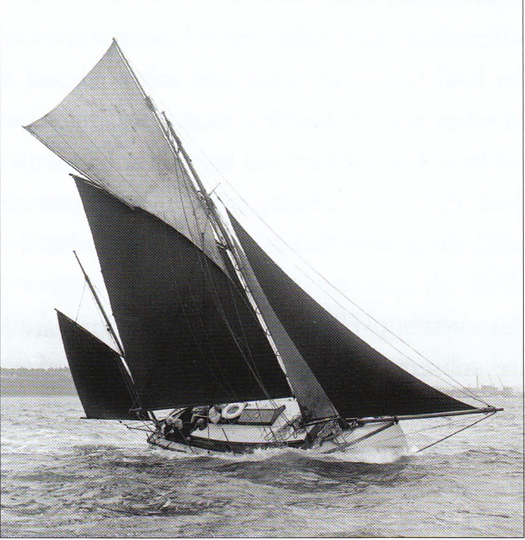
Mike Richardson's Betty racing in the first gaffers' race of 1959, four years before the OGA was formed. Her owner, who ran the famous Elephant Boatyard on the River Hamble, was a man of many sailing interests – he also was a regular offshore competitor with his S&S-designed fiberglass She 31 Arctic Skua. Photo courtesy OGA
Though the name of the Association and its burgee may have emerged fully formed in 1957, little else did. The first race wasn't held until 1959, off the River Hamble, and it became an annual event of sorts. But it was round on England's east coast in the Thames Estuary that the encouragement of the preservation of gaff rig found its most fertile ground, and on Saturday July 20th 1963 the Old Gaffers Race from the Blackwater to Harwich got going with 30 starters, though only seven finished as a forecast sou'wester became a light easterly.
The winner was one of the oldest boats in the fleet, Fanny of Cowes, and the OGA came formally into being. Despite the frustrations of that first East Coast Race, there were 35 starters the following year, when there was also a race for gaff-rigged yachts at the Royal Gourock YC in the Clyde. So there was clearly a grass roots movement of support for gaff rig at a time when plastic boats and alloy Bermudan masts seemed destined to wipe them out. But as many of the gaffers had eccentricity as their default mode, getting them into any cohesive organization was a slow process.
Yet over the years it has gradually developed, building up area associations, and based almost entirely on an enthusiasm for gaff rig and vintage craft which may be shared and displayed by people who do not necessarily have gaff rigged boats themselves, nor indeed vintage craft of any type. In fact, there's a significant segment of the membership made up of sailing folk who don't quite fit into any specific category, and nor do their boats if they have them, but the OGA provides them with a congenial spiritual home.
There has been a Northern Ireland branch since the late 1980s, while a Dublin Bay branch is of similar vintage, and in times past it was notably active when Dublin port and Howth were home to a vibrant flotilla of restored Galway hookers. But of course the revival of the Galway hookers was something which had been happening independently of similar movements elsewhere in Holland and England.
It was in 1974 that the last commercial cargo of turf was sailed out from Connemara to the Aran Islands on a hooker. Yet some of the old boats were kept going for the annual sailing events in the Land of the Sea, particularly the MacDara's Festival on July 16th. Then in 1976 Johnny Healion of Dublin appeared in Connemara with the magnificently-restored Morning Star, and the show was back on the road. I can vividly remember sailing from Clew Bay down to MacDara's Island in 1978 with the late great Tad Minish on his Finisterre yawl Kiff in order to witness the revitalized gathering of the boats and their racing, and the sense of a new spirit of enthusiasm being allied to a tradition half as old as time was palpable.
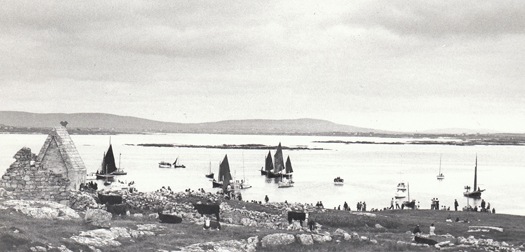
The traditional gathering of the Galway hookers at St MacDara's Island in Connemara, July 16th 1978. It was in 1976 that Johnny Healion had inspired the hooker revival with his restoration of Morning Star. Photo: W M Nixon
Thus the idea of an association simply devoted to venerating gaff rig seemed almost absurd in Connemara – what other sort of rig was there? But with goodwill on all sides, the boats of the west in their alternative times as boats of the east around Dublin Bay brought a huge infusion of sailing vitality to the Dublin Bay OGA, and with now-legendary regattas such as that at Portaferry at the entrance to Strangford, the message was spread.
Ironically, when the OGA itself had come into being in 1963, it was the very year that John Kearney was persuaded to oversee the conversion of the Dublin Bay 21s in Dun Laoghaire from gaff to Bermudan. But the Howth 17s have stayed loyal to gaff – complete with jackyard tops'ls – so as the Golden Jubilee of the OGA approached with the festivities planned for Dublin and Belfast, it seemed an ideal opportunity for the 115-years-old Howth 17s and the 50-years-old Old Gaffers Association to get together for the first time, and one of the people who worked behind the scenes on making this happen was DBOGA Committee Member Sean Walsh.
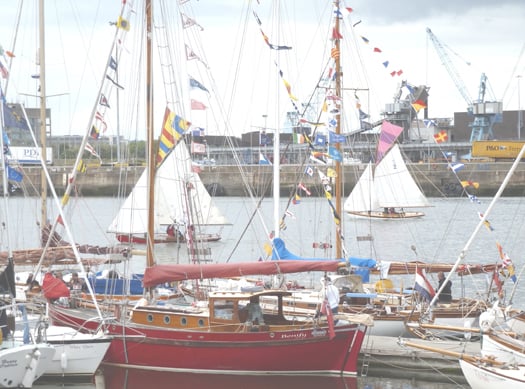
A dream comes true. The Howth 17s arrive in to join the OGA Golden Jubilee celebrations at Poolbeg Y & BC on Saturday June 1st 2013. Although the Howth 17s had been sailing under gaff rig for 115 years, and the OGA had been in being for fifty years, it was the first time the two groups had got together. Photo: W M Nixon
His life-story is a tale for our times. Born in Cork to a family north of the Lee, he was one of eight children, but as siblings appeared on an almost annual basis, he was effectively adopted by his aunt and uncle, who were childless. He cheerfully claims to have been spoilt rotten, but he grew up in a thoughtful household. When we remember that Cork was effectively Ford City in those days, the fact that his uncle drove a Morris Minor tells us much. It tells us even more that, when the little car needed new big-end bearings, his uncle educated young Sean into the ways of engineering and mechanics by having him as helper one Saturday morning while the uncle in his garage at home lifted out the engine, replaced the bearings with Sean to hand him tools and parts as required, and then re-installed the engine, all neatly in time for lunch.
His schooling was with the Christian Brothers at North Mon, where some of the Brothers took it into their heads to acquire an ancient little leaky fishing boat around 25ft long with a seized engine. They made it seaworthy or at least capable of floating, got the engine back to life, and based it at Kilbrittain on Courtmacsherry Harbour for a sort of informal sea training course for those pupils who had helped with the boat's restoration, which naturally included young Sean Walsh.
With his enthusiasm for getting afloat developing rapidly while still at school, having spotted the plans in a DIY magazine for a build-her-yourself 16ft canoe designed by Percy Blandford, he built three of these slim craft through two rooms in his parents' third floor attic. It was a neat building job, an elegant framework skinned by heat-stretching PVC sheet. His successful business plan was to sell two to finance his own ownership of the third. Getting them out of the attic was a hairy business which involved sending a messenger rope over the top of the house to provide a sort of crane, as the boats had to emerge cleanly and horizontally through a window still small despite the removal of its frame. But somehow they were safely lowered to a crowd of helpers far below, and the flotilla was ready to cruise.
And what a cruise they had, starting from the sacred location of Gougane Barra on the headwaters of the River Lee among the mountains away to the west, and spending three weeks descending the valley to Cork using wheels from a cannibalized Silver Cross pram to help them get the canoes through the many portages.
With hessian sacks made only slightly waterproof by a sort of plastic coating to provide a tent, and with eternally damp blankets rather than sleeping bags, it was a hardy life. But they throve on it and fed well with more than a little foraging, reckoning that the farmers owning the riverside potato fields wouldn't begrudge the three hungry young voyagers a feed of liberated spuds each night.
After school, Sean's first fulltime job was on the production line in the Dunlop Tyre plant, a Leeside institution back in the day. But even though with overtime he was soon earning enough to acquire a Triumph Spitfire sportscar, he was restless. In 1960s Cork, the class barriers were harshly drawn. But he yearned for something which provided outlets beyond the skilled manual work which seemed to be his allocation in life. He'd long been interested in radio, electrics and electronics, and the Radio & Electronics Institute in Cork provided a course which could qualify him as a ship's radio officer, so he sold the car to pay for the course.
As for transport, he was able to use his canoe to commute from home down the Lee to the riverside Institute – "I learnt a lot about tides". And in due course he qualified, and then was offered a job, due to start from Liverpool in five weeks time, as a Ships Radio Officer.
He had his new uniform bought and all when his aunt showed him an ad in the paper for electronic technicians up above in Dublin, working for some outfit called IBM. Those who would persuade the Irish to become a seafaring nation one and all should realize that they should be working on the womenfolk and their views on the matter. His aunt was secretly horrified at the thought of her beloved nephew going off to sea. So as he'd the five weeks to put in before he joined his ship, Sean did her the courtesy of applying for an interview, and in those pre-Google days, he went to the local library to learn a bit about IBM.
Anyone who has read the recent Steve Jobs biography will have learnt of the reverence with which IBM is held in the grown-up business community. Back in the 1960s, the company was at the exciting stage of building up its unrivalled reputation. It looked like a stimulating place to work, and young Sean Walsh was so interested by what he'd read about it that he sailed through the interview, within a week he'd been offered a job which in 1969 began his 36 year career with IBM, and the Radio Officer's uniform went into the wardrobe.
But while he may have been working in IBM computers for some of the key companies in Ireland and living in Dublin, if anything his interest in boats increased, and now it encompassed sailing. Having proven his business plan with the success of building three canoes and keeping one for himself, in the front room of his first house (it was in Portmarnock) he built three Fireballs, and after they'd been approved by the class measurer, a young fellow called David Lovegrove, he was able to sell two and keep the third to teach himself to sail on Broadmeadow Water in Malahide, most of which is a safe depth which means you can stand up when you capsize. As he did a lot of capsizing learning to sail a Fireball single-handed, he did a lot of walking around in water up to his chest.
But he learnt to sail too, and got involved with the sailing scene at many levels. Like a lot of men with young sons, he built a Mirror dinghy and did miniature cruises. Then at another stage in life, he was active as an instructor in Glenans. Having been self-taught in sailing, he had much to contribute at the Glenans base on Clew Bay.
However, the more he became involved with boats and sailing, the more he found himself drawn to traditional craft, and gaff rig. Meanwhile his career with IBM was blossoming as the company became world leaders. In a new setup in which, instead of selling products, their philosophy was to provide a total package of solutions, he found himself becoming a project manager. IBM had discovered that with computers, somebody with a technical background talking with genuine enthusiasm about what the machines could do was actually much better at selling to hard-headed executives than the traditional salesman with his shallow patter.
So in this multi-functional role, he went along for a first meeting with the Financial Controller of Readymix Concrete, who'd expressed interest in an IBM system. In preliminary pleasantries, Sean said something about the peculiar weather. The FO agreed, saying it was unusual to get so many sou'easters at that time of the year. So Sean took a conversational flyer:
"What kind of a boat do you have?"
"She's a bit unusual. She's called a Heard 28. She's a gaff-rigged cutter, looks old style but has a fibreglass hull. She's a super boat."
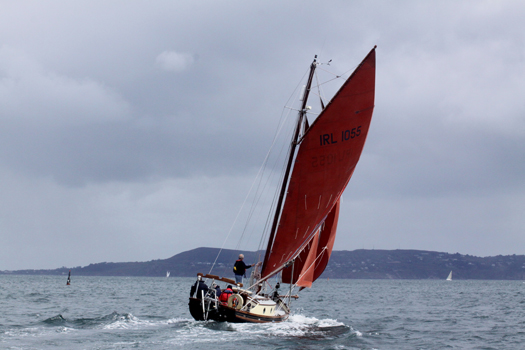
Storming along. Tir na nOg is a Heard 28, designed by Percy Dalton and based on the Falmouth Working Boats which are legally required to dredge for oysters under sail only. The Heard 28 is one of the most successful of the "plastic gaffers" which now form a significant part of the fleet of the OGA. Photo: Dave Owens
Thus did Sean Walsh meet Gerry McEvoy, owner of the Tir na nOg of Howth. They talked boats for a solid two hours, then - the working day being long over - agreed within five minutes the outline of the system IBM would provide for Readymix. And then, once the system Sean designed was installed and working satifactorily, he accepted an invitation to go sailing on Tir na nOg, and now, 22 years later, has been sailing on her ever since.
Sadly, after a number of years of being shipmates together, Gerry was to die cruelly young. But in partnership with another sailing friend, Gerry Murtagh, Sean bought Tir na nOg himself. It was in 2003 that they sailed into Howth Harbour and were invited into an assembly of gaff rigged boats convivially gathered at Howth Boat Club at a Dublin Bay Old Gaffers Association event. As the evening went merrily long, a sister-ship of Tir na nOg's came into port and joined the party. It was Englishman Mike Shaw and his son, cruising round Ireland with the Susan J.
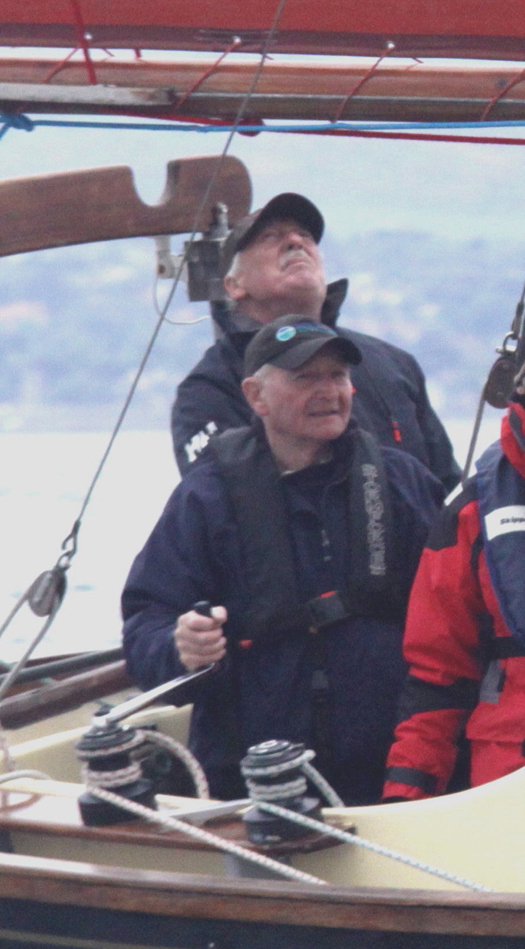
The top men. Mike Shaw (foreground) crewing for Sean Walsh (on helm) aboard Tir na nOg during the race for the OGA's Leinster Plate in Dublin Bay Photo: Dave Owens
Mike was a longtime Old Gaffers Association stalwart, so Sean Walsh found himself getting the OGA message both at local and central levels in a big way. He embraced the concepts of the organization with such enthusiasm that, in the eleven years since that fortuitous meeting in Howth, he has served on the Committee of the Dublin Bay OGA, and as its Honorary Secretary and DBOGA President. And he has also been on liaison duties with headquarters where his friend Mike Shaw was being quietly positioned in order to be President when the Golden Jubilee came around in 2013. Thus when the OGA Golden Jubilee Round Britain fleet came west to Ireland in June 2013 for major events in Dublin and Belfast, Sean had the satisfaction of seeing his hopes of the Dublin fleet, well supported by the Howth 17s, make the Riverfest in the Liffey and the two special races in Dublin Bay into one of the outstanding events of the entire Golden Jubilee.
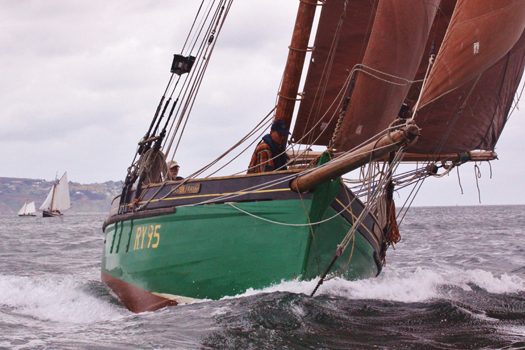
The OGA's fellowship of the sea. Noted Irish explorer and traditional boat sailor Paddy Barry is just visible at the helm of Joe Pennington's 1895-built Manx longliner Master Frank as they prepare to start in the race for the Leinster Plate in Dublin Bay. Photo: Dave Owen
After such a year, the following season might threaten to be a bit of a downer for the OGA, but the new President doesn't see it that way. Though he turns 70 this year, Sean Walsh is full of beans, and while he may have retired from his long and successful career at IBM, he's not he retiring type. From the work point of view, he keeps himself busy as the Yanmar Marine Engines agent for Ireland's east coast, for there's no way he's going to let all that engineering talent and experience go to waste.
And as for the continuing development of the OGA, he's fairly bubbling with ideas. His own lifetime experience is invaluable in helping the Association develop its concepts about the best ways of introducing young people to sailing and traditional boats, and keeping them interested. As for his unrivalled experience in computers, that too is of unique value for an association which, while specializing in traditional craft, relies increasingly on the latest technology to spread its messages and keep its boats and people records up-to-date.
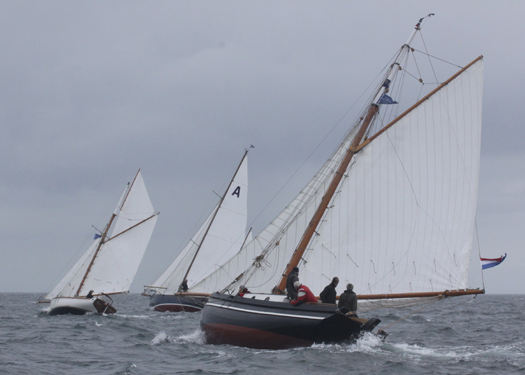
Dutch sandwich. Ainmara (Dickie Gomes, Strangford Lough) seen between Raven (left) Fred Schottman, Makkum, Holland, and Cine Mara (Rik Janssen, Makkum) shortly after the start of the race for the Leinster Plate in Dublin Bay. The Dutch boats made up the largest contingent which went right round Britain for the OGA Golden Jubilee, and in 2014 they will be celebrating the tenth anniversary of their own branch of the OGA with a cruise-in-company in The Netherlands. Raven is a Lyle Hess 28 while Cine Mara is steel built based on the classic Galway hooker design. Photo: Dave Owens
As for life afloat, while 2013 was the Golden Jubilee of the central association, 2014 is the Tenth Anniversary of the lively Dutch branch. The Dutch boats were among the stars when the OGA came to Dublin last June, and their planned cruise-in-company for all interested OGA members through the incomparable waters of the Netherlands in July this year is expected to be the highlight of the season.
So when I met the new President shortly after his return from London this week and considered the demands on his time with the many active local branches, the up-dating of central administrative systems, and the special demands of the Dutch celebrations, I could only suggest that he was going to need a fulltime Personal Assistant.
"I have one already" said Sean Walsh, "I meet him first thing every morning when I look in the mirror".
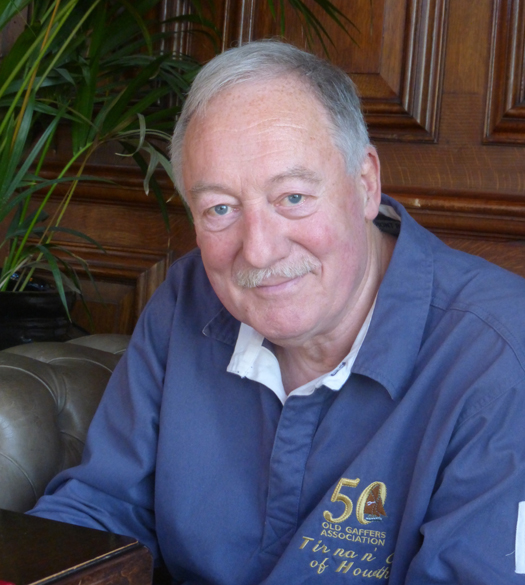
Sean Walsh, eleventh President of the Old Gaffers Association. Photo: W M Nixon
#catamaran – It's the time of year when any sensible sailor is dreaming of skimming across warm blue water without a care in the world, and feeling at one with the ocean. W M Nixon introduces an organisation which is built around this aspiration, yet has a deeper meaning for Pacific island communities.
An island is both an escape, and a prison. On one side of the coin, it seems to provide the means of getting away from the tedium and pressures of over-crowded mainland life. On the other, you're trapped on it if you don't have some sort of choice and control over your own coming and going.
For most of us around boats in Ireland, the ability to sail to islands is one of the greatest attractions in what we do. Sailing to our small islands is pure joy, truly satisfying in a way scarcely justified by the modest distances involved. And being on small islands is a delight. Yet generally we don't want to live on an island year in, year out.
This may seem absurd to those who write off Ireland itself as no more than a small damp island somewhere out in the Atlantic. But for us living here in reasonable content, Ireland is just the right size. It's a complete place, a proper country – that it's an island is almost incidental. We don't really think of it as somewhere you can drive across in only three hours. It's the size it is, that's the way it is, and anywhere else is just unnaturally large.
Probably we actually think of Ireland as a world unto itself – a small but viable landmass which happens to be surrounded by water. So if you want somewhere distinctly different, it's not the obvious one of great open continental land spaces of tundra or prairies or savannah, with unending mountain ranges or trackless tropical forest. On the contrary, the most complete contrast with Ireland is to be found in the Pacific, where the world is almost totally one of water, with tiny islands dotted about at vast distances, some of them with populations so small and remote that they're barely viable communities.
In such circumstances, the people on the islands have traditionally needed to be truly at one with the ocean, embracing it with a natural affinity which meant they were able to voyage long distances in relative comfort with craft which may seem primitive to us. But those vessels too were in harmony with the sea – they didn't battle it, rather they went with its moods, leaving only the lightest of furrows in the ocean astern.

Despite being 73ft long and able to carry a crew of 16, the working weight of these vakas is only 14 tons, and they are easily driven with a relatively small sail area.
The key to it all is the temperature of the sea. When you have an ocean which isn't going to give you hypothermia within an hour or two of immersion, you can voyage on light boats which skim the water. But in our northestern end of the North Atlantic, despite the tail end of the Gulf Stream washing our shores, here in Irish waters we need boats we can be in, rather than boats we're on. We need boats which provide a genuine level of protection from the sea and its punishing cold almost regardless of how we handle them.
So, much as we like to feel we have an understanding with the sea, in some sort of empathy, in fact we're battling with it. Even the surfers who have been putting in such fantastic performances on the west coast in recent days are more akin to bullfighters than sea creatures. It's all about controlling something which is bigger than they, something which arises mightily but then dies and disappears, yet the surfer remains, banging away with his jetski to hit the right spot.
For sure we respect the sea, but as this week's vids of the Safehaven boats being tested off Cork have shown, we aspire to boats which can continue to go about their business almost regardless of sea conditions, while providing complete protection for those on board. Although we may seem to have experienced some overwhelming weather these past few weeks, underlying our attitude is the notion that we know what's going on, that we're in control. It may seem a fine example of human folly and delusion. But the reality is that for most people in what we used to call the West, life is pretty much under control. We live by the clock. Trains, boats and planes leave and arrive pretty much on time. We build and control the machines, and the machines control the world. When disaster headlines erupt, it's only because this comfortable and mechanical state of affairs has been temporarily upset. But normal service is soon resumed.
Set against this powerful certainty, small and isolated island communities in the vastness of the Pacific become fragile. While the elders may live naturally in the old ways and understand the workings of the sea and the necessary regularity and ordinariness of island life, their younger people know only that in the outside world, life is different. There's more readily available entertainment and excitement. There's a wonderful life of machines and timetables. Anyone who can pay the fare can go when and where they please. And huge numbers of people seem very happy with this state of affairs.
So the island becomes a prison, not a paradise, as the old voyaging skills decay. The young people are no long capable of sailing away to distant places as their ancestors did, yet they lack the money to avail of the air travel which is often the only way to get off the island. And the soul of the community, if not actually lost, is sorely troubled. But there are those who feel that while the islands in the sun certainly have to adapt to the dominating realities of modern consumer-oriented life and global communication, they also reckon there's a way in which the old ocean voyaging traditions can be re-jigged to provide a meaningful experience for modern islanders, young and not-so-young.
When that noted solo sailor Sam Davis of Strangford Lough was cruising the Pacific in recent years with his Rival 41 cutter Suvretta, he met up with a group in Tonga who so enthused him that when he finally arrived in our harbour on his way back to Strangford Lough last August, far from talking of his own remarkable voyages, he was almost completely absorbed by talking of the Tahitian Voyaging Society and their fleet of 73ft catamarans.
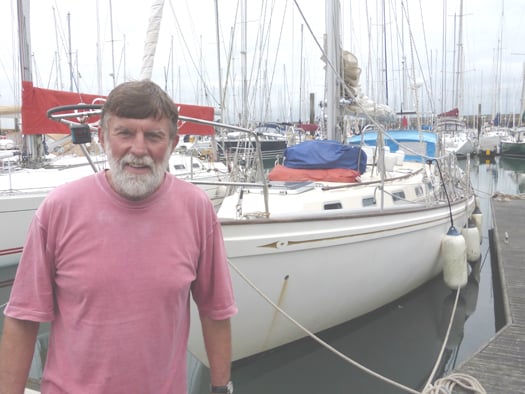
Sam Davis with his much-travelled Rival 41 Suvretta in Howth, August 2013. Photo: W M Nixon
That and mung beans. Sam is into mung beans in a big way. He seems to have lived on them for much of his voyage up the Atlamntic back to Strangford Lough. He was so keen to push the case for mung beans that I didn't have the heart to tell him that in our house we eat little else, apart from the occasional potato and some porridge. So he gave his sermon on the beans, and then we got back to the boats.
And what boats they are. Everything about them is seductive – the way they sail, and the places they sail to. These are not brutal boats of the modern world which rely on ballast keels and high tech engineering and large auxiliary engines. Though their hulls are fibreglass, they are as simple as possible, relying on wind and solar power, and leaving no trace as they sail sweetly across the sea for thousands of miles.
The Tahiti Voyaging Society is the inspiration of German sub-aqua film maker Dieter Paulmann, and in 2011 this remarkable initial fleet of seven 73ft catamarans began voyaging. Three years down the line, they've sailed tens of thousands of miles, and now other islands want to get in on this inspirational programme.
This is where Sam and Suvretta get involved. After wandering to many strange places beyond the seas, they fetched up in Tonga and stayed for some time. Another voyager, Christy Butterfield, the woman boss of a Pacific charter ketch operation, introduced him to her crew – most of whom were Tongan - and then when the big catamarans (the Pacific name is a vaka) arrived in port, they brought him up to speed on what the boats were doing, and how they hoped that Tonga would one day have one if its own, just as places like the Cook Islands, Aotearoa, Tahiti, Fiji and Samoa already do.
The simple life for seafaring. Two of the big cats in port in Tonga, November 2012, with Hine Moana next the quay. Photos: Sam Davis
As it is, Tongan sailors have put in many sea miles as visiting crew on other islands' vakas and one of them - Aunofo Havea – was the first woman skipper in command for a long voyage, sailing the Hine Moana from Tonga to New Zealand. So the spirit is there, the ability is there, all they need is support.
In an Ireland which is currently devoid of any sail training ships north or south, it may seem a bit far-fetched to be voicing enthusiasm for what is in effect a traditional sail training vessel for the Pacific islands. But if you happen to see Sam Davis bearing down on you with a determined look about him, be prepared to take on board an impressive load of information about Pacific voyaging and the vaka programme. And a bit of precautionary research on mung beans wouldn't go amiss either.
Was This The First Round Ireland Voyage?
Sailing round Ireland, whether cruising or racing, is a fascinating and uniquely satisfying experience for any Irish sailing enthusiast. Who did it first from an Irish port? W M Nixon introduces a possible candidate from 1860.
We try to tell ourselves that cruising round Ireland is no big deal these days. And even though the biennial Round Ireland Race from Wicklow (this year's starts on Saturday June 28th) throws crews straight into whatever the weather happens to be providing on our exposed Atlantic coasts, when you've become accustomed to hearing the tales of extreme sailing off Cape Horn by Volvo racers and the like, Ireland's west coast in summer seems like an old pussy cat by comparison.
Yet despite the all-round sailing abilities of modern boats, the safety and convenience factor provided by reliable auxiliary engines, and the proliferation of new or improved harbours with convenient pontoon berths on every coastline, cruising round Ireland still has the capacity to feel very special indeed. This is particularly so if you allow yourself at least four weeks to do justice to the extraordinary variety of ports, harbours and coastlines that you'll encounter during a voyage which can be 1200 miles long if you give the most interesting areas the attention they deserve.
As for racing round, most Irish sailors would like to have at least one racing circuit in their CVs. Others become almost addicted to the guaranteed satisfaction of being there in the start at in late June in every even-numbered year, while the bonus of completing the course is still magic. And as for getting among the trophies, well, that's simply ecstatic.
The essence of the round Ireland mystique lies in doing it from an Irish port in an Irish boat. The earliest known distance race along the Irish coast occurred in 1860. It was from Dublin Bay to Cork Harbour, with one of the smaller boats winning despite there being no handicaps. This "first of the first" was the 39-ton cutter Sybil (Sir John Arnott), sailed by the renowned amateur skipper Henry O'Bryen. But despite the race being sailed again in 1861, 1862 and 1888, and despite the enthusiasm from the 1850s onwards for "cross channel matches" between the east coast of Ireland, the North Wales/Liverpool area, and the Isle of Man, the notion of a round Ireland race, if it did arise, simply didn't get any significant support, and thus the first race round came as part of something else.
In the extravagant golden days of 19th Century yachting with enormous craft sailed by large professional crews, Ireland might be taken in as part of a circuit cruise of the islands of Great Britain and Ireland. And the first race round all the islands took place in 1887 in an anti-clockwise marathon from Southend in the Thames Estuary, organised by the Royal Thames YC to celebrate Queen Victoria's Golden Jubilee.
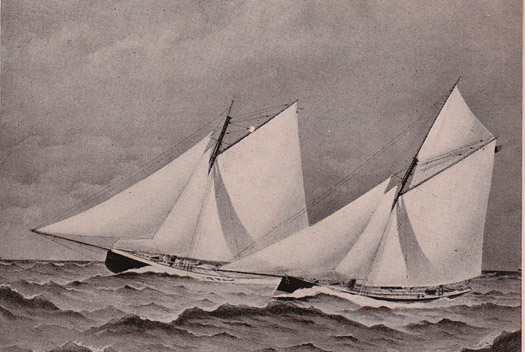
The 80-on Genesta (right) was winner of the first Round Britain and Ireland Race in 1887. She is seen here two years earlier in her unsuccessful America's Cup Challenge against Puritan
In a fleet of eleven starters, the smallest was the 40-ton cutter Sleuthhound, while the largest was the 255-ton schooner Selene. Only six of this pioneering fleet finished, and the winner was the 80-ton cutter Genesta (Sir Richard Sutton), which had unsuccessfully challenged for the America's Cup two years earlier. Inevitably, one muses on the prospects for current America's Cup challengers, successful or otherwise, in sailing this offshore course....But enough, the fact is that this was, in a sense, an early round Ireland race. And as for cruising round Ireland, that doughty cruising trailblazer R T McMullen, a Royal Thames member, had not been permitted to take part in the Golden Jubilee Race as his 16-tonner Orion was considered too small. But he sailed the course anyway as a long high-speed cruising passage, and thus in 1887 we had an early round Ireland "cruise".
So that bit of information goes into the fascination of the story of sailing round Ireland. And the more we know of the pioneering days of sailing, the more we are astonished by what some of the early cruising folk achieved when the sport was undeveloped, and the secrets and local knowledge of the remote coastlines of Ireland, the bits that were barely outlined in the official charts, were jealously guarded by people who didn't want them known. Smugglers and pirates for instance, or those who hoped to sell local knowledge on a regular basis, such as those retained as personal pilots by strangers cruising the coasts.
Then too, the development of cruising round Ireland has been much affected by the turbulent national history. Cruising and simply sailing along the coast are quintessentially activities of peace and prosperity. You need peace to cruise, and you certainly need some level of individual prosperity for the yacht owners themselves, though speaking personally a general air of prosperity ashore when you get to port is something which adds greatly to cruising enjoyment – "picturesque poverty" gives me the creeps
When we first cruised round Ireland in 1964, the western and southwestern seaboards were only just beginning to come to life after many decades of low economic activity, and it was good to see it. But it's much more enjoyable to cruise those areas these days, when – despite the recent recession – there's a lot of life about the place, and local sailing is thriving. And for those who would suggest that it's getting too crowded, I can only say you're not trying. There are many wide open spaces and secluded uncrowded anchorages if you look for them, and have a boat capable of self-sufficiency with proper anchoring arrangements which don't rely on pontoons or visitor's moorings.
But every time you do the circuit, the curiosity about who did it first from an Irish port becomes ever greater. Until the Great Famine of 1845, there had been flowerings of recreational sailing along the Atlantic coasts, with the Royal Western of Ireland Yacht Club emerging from a regatta at Kilrush on the Shannon Estuary in 1829. In an era when those who had wealth and free time had lots of it, and the entertainment industry was in its infancy, the yachts of the time were kept busy.
At its most prosperous, the Royal Western had eighteen substantial yachts based in Kilrush Creek in 1838. It's surely likely that in some seasons their delivery passages to the early regattas in Galway Bay, Belfast Lough, the Clyde, Dublin Bay and Cork Harbour inevitably became round Ireland "cruises". But as the Royal Western faded away in the horrors of the late 1840s, such things were forgotten.
The potential round Ireland sailing craft included another Shannon Estuary boat, the Knight of Glin's notably successful racer Rienvella, a 30-tonner which in 1834 was recorded as winning in both Galway Bay and at Cork. And of course the Corkmen were no slouches in racing and in cruising to races. In 1830 Caulfield Beamish of Cork turned up in Belfast Lough with his cutter Paddy (which he'd designed himself) to race against the boats of the nascent Royal Northern YC, a group which in 1838 became totally Clyde-based, though that is not necessarily attributable to the fact that the Cork boat beat them all back in 1830.
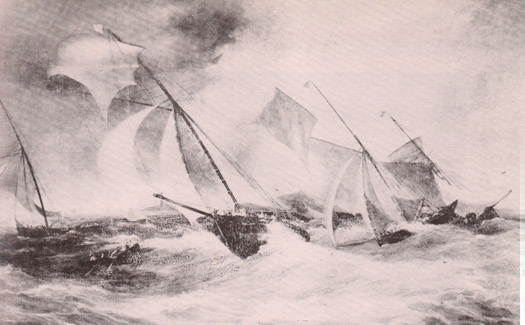
Caulfield Beamish's Paddy from Cork winning a race in hectic style in Belfast Lough in 1830.
Be that as it may, boats like Paddy and other top racers of subsequent decades in the 19th Century regularly made long passages to the main racing venues, and a west coast boat returning from events in the Irish Sea/North Channel area would naturally contemplate going northabout. But while some owners enjoyed doing these voyages, they were thought of as cranks by their peers, who expected inter-event deliveries to be done by professional crews, while the gilded owners just turned up to strut their stuff at the regattas.
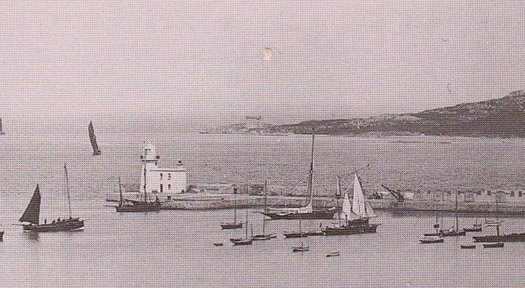
Judge Boyd's 34-ton yawl Aideen on her mooring in Howth in 1889, the year he cruised her round Ireland.
Thus it was a long time before round Ireland cruises as we recognise them today were being undertaken, and for many years the earliest proper round Ireland cruise we definitely knew of wasn't undertaken until 1889, when that great man Judge Boyd of Howth (he figures in Joyce's Ulysses) cruised round in his 34-ton 50ft yawl Aideen. And the only reason we know of it was because it was mentioned in a profile of the Judge in a Yachting Monthly of January 1910. Yet the way it was mentioned suggests that, while rare, by 1889 Round Ireland cruises were by no means a complete novelty. But how on earth to find out about earlier ones?
Enter Wally McGuirk with a Christmas present. The loan of an interesting book may strike you as a weird Christmas present, but when the lender is Wally McGuirk, it's a gem. Wally's business card says it all: "We buy and sell anything marine". He's also a certifiable innovator, and serial boat builder – his current craft, the handsome big steel cutter Swallow, is the eighth boat he has built for himself, and is doubly interesting through being the last boat designed by O'Brien Kennedy.
But that's by the way. Somehow in his mega-busy life, Wally finds time to trawl through second-hand bookshops, and in one in England he came across a facsimile printing of a jewel of early cruising which, to my shame, I'd never heard of, but we'll try to make amends now.
You may know of the Country Diary of an Edwardian Lady, a private journal of 1906 which was a runaway success when it was published in facsimile in 1977. Well, The Log of the Olivia, published in facsimile by Richmond Press in England in 1983 from the original which had come down the ages to distant relatives of the author, is cruising's equivalent to the Country Diary, except that it's even more historically significant as it dates from the period 1859 to 1867. It is the personal sailing diary, illustrated with his own skilled and charming sketches, of one William A Power, who sailed from Kingstown (now Dun Laoghaire) on Dublin Bay in his 25-ton cutter Olivia.

The many voyages of William Power's 25-tonner Olivia from Dublin Bay between 1859 and 1867, which included two round Ireland cruises They sailed so many times through the Irish Sea and the North Channel that they may well have worn a groove in the ocean. "RMYC" refers to Royal Mersey YC, despite the fact that Olivia was based in Dublin Bay, but Power later also listed the Royal Irish as his club.
This excellent facsimile is primarily for print connoisseurs and bibliophiles. As someone who thinks books should be devoured rather than venerated, this is strange territory for me. And equally, in our era of Google, the virtually total blank which was drawn in 1983 in filling in the background to William Power and his fine cruising yacht is almost bewildering. Yet even in 1983, a quick look at the two volume guide to Yachting, first published by the Badminton Library in 1894, would have revealed that Olivia's builder, Michael Ratsey of Cowes, was well known in sailing circles as a boatbuilder and designer, and very active through the middle decades of the 19th Century, with one of his best known racers, the cutter Myosotis, being built as late at 1877.
Thus in being the owner of Olivia, William A Power clearly knew his stuff, but whether he commissioned the boat new or bought her second hand we still don't know. At 25 tons Thames Measurement, she would have been around 45ft in overall length, for the 1860s preceded the era when TM yachts became absurdly narrow and thus unreasonably long in order to exploit the measurement rule.
We can get a very good idea of what Olivia looked at by considering the bare hull of The Nita, which was retrieved from rural seclusion in the Irish Midlands by Hal Sisk and his team in 2006. The Nita was designed and built in iron in 1868 by Bewley, Webb and Co of Dublin for the Dopping-Hepenstal family of Lough Gowna in County Longford. Despite the fact that in her long sailing life The Nita never left the waters of Lough Gowna, she was of an able seagoing shape very typical of her time, and as she too was 25 tons TM, 44ft LOA and 12ft beam, the similarities to the Olivia are remarkable.

The Nita, designed and built by Bewley, Webb and Co in Dublin in 1868. In her dimensions and lines, she is remarkably similar to the Olivia. Photo: Iain McAllister
However, in every other way, the life of the wide-ranging Olivia was totally different. At the moment we know nothing of William A Power except that he was initially recorded in Hunt's Universal Register of Yachts as a member of the Royal Mersey YC (cross-channel inter-club links were strong in those days) and the Royal Western of Ireland YC, which by the 1860s had moved its base from the devastated western seaboard to Dublin Bay. Then Hunt's in 1868 records Power as being a member of the Royal Irish YC, which begins to make more sense, and also the Prince Alfred, later the Royal Alfred YC.
Writing this in the midst of the two week midwinter shutdown, we have no means of accessing membership records of any of these clubs, but it something which will be a fascinating trail to follow. As to William A Power, inevitably you'd guess he was a Power of Power's Whiskey, for the extent of his cruising suggests someone who was on an unearned income. But not an excessively generous one – by the standards of her time, the Olivia was a very modest cruising yacht, and Power cruised her with himself in command, and one or two paid hands, plus any sea-minded friends he can persuade to come along.
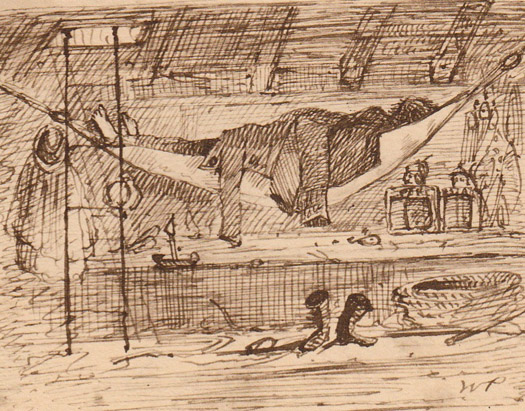
Grabbing some shut-eye in the crew's quarters during Olivia's round Ireland cruise in September 1860. While reasonably comfortable, this was no luxury yacht
Yet despite the limited resources, the cruising he did in the period 1859-1867 was simply sensational. South to Spain, east to Norway, north to the Faroes, and just about everywhere else in between. In a programme like this, in which the Olivia carved her own private roadway up and down the Irish Sea and North Channel, almost inevitably a round Ireland cruise was fitted in, but it seems to have been done in 1860 almost as an afterthought, as the Olivia had already cruised that year north to Orkney and Shetland.
It was Thursday August 30th 1860 when they sailed south from Dublin Bay, so it was a September cruise – not a month normally chosen for a round Ireland venture. And while the coasts they'd visited in the cruises of 1859 and the other cruises of 1860 had been relatively prosperous, the west coast of Ireland in 1860 was anything but.
Thus you get a feeling that the cruise was being done almost out of a sense of duty rather than in anticipation of enjoyment. And as knowledge of any special cruising attractions along the west coast had not yet been assembled in published form, by the standards of today's round Ireland cruises the experiences "enjoyed" by Olivia's crew were very thin indeed. In Cork Harbour, for example, the peak of the season was clearly well past, and up the west coast they were stuck in Cleggan for almost a week as one wet gale followed another.
After three very mixed weeks, they returned to Dublin Bay. But in due course, Power and the Olivia did another round Ireland cruise which seems to have afforded him more pleasure – that's when he did the summery sketch of the boat in Sligo Bay. In a brief initial scanning of this remarkable book, you can very quickly see where the author is enjoying himself – the word count increases and the sketches become lively, whereas when the weather is bad, you can have about four words devoted to an entire week stuck in port.
Power tells it all, including the fact he put Olivia aground on a falling tide in Achill Sound (many cruisers have done the same since), but as he carried legs they were able to keep themselves upright. To pass the time, the crew hunted down a seal that provided a very high protein diet for the rest of the voyage, which reminds us this was a very long time ago - it's surely not something a contemporary crew would contemplate.
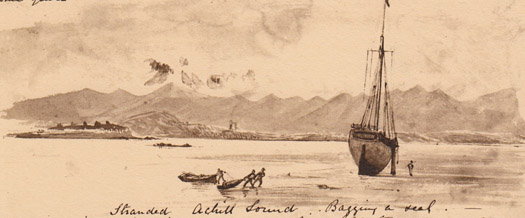
Caught out by a falling tide while straying from the channel in Achill Sound, William Power and his crew put out the legs to keep Olivia safely upright, and then bagged themselves a seal to supplement their diet for the non-stop passage the rest of the way home to Dublin Bay.
All this is just from an initial brief impression of The Log of the Olivia. It was the night before Christmas Eve when Wally appeared out of the dark with this extraordinary book. With 2014 upon us and festivities finally drawing to a close, it's clear that one of the top questions will now be: Who was William A Power? Meanwhile, a prosperous New Year to everyone.
Wild Oats XI Does It Again in Sydney–Hobart Race
#rshyr – Veteran owner Bob Oatley's Reichel Pugh 100 Wild Oats XI, skippered by Mark Richards, has taken her seventh line honours win in the Rolex Sydney Hobart Race, with an evening finish at Hobart at 19.07.27 hrs AEDT writes W M Nixon.
Up-dating our report from last night's midnight posting of Sailing on Saturday, the slim hulled fleet leader continued to build on her light airs lead over Anthony Bell's much beamier hundred footer Perpetual LOYAL, the former Rambler 100. The gap between the two became even greater when Wild Oats began to feel the benefits of a building nor'easter the further south she got, while Perpetual was virtually becalmed.
Thus the gap expanded to more than fifty miles. But then as Perpetual began to feel the breeze, she showed her potential and was zooming down the Tasmanian coast at speeds of up to 28.2 knots, closing the gap to 25 miles. However, by this time Wild Oats was shaping her way into the Derwent estuary and the often tricky final virtually inland stages to the finish. She was comfortably across the line in mid-evening in an easing breeze which had her speed down to 9-11 knots, though at one stage while in Storm Bay the power in the new nor'easter had her down to storm jib and heavily reefed main.
But as darkness closes in, the wind has gone in the Derwent, and while Perpetual LOYAL has only 18 miles to the finish, her current speed of 3 knots could make it a long and frustrating night, and though she has a lower rating than Wild Oats, it looks unlikely she'll beat her on handicap. But for now Wild Oats XI is the undisputed 2013 holder of the prestigious Illingworth Cup for first to finish, named in honours of the noted English offshore racing skipper Captain John Illingworth who, in 1945, suggested that a proposed post-Christmas cruise-in-company from Sydney to Hobart should be sailed as a race instead. He won it too, and the rest is history.
Now with the Tasmanian weather into a more volatile state, all sorts of possibilities arise for the new holder of the Tattersall's Cup for the overall winner under IRC. Wild Oats did the double in 2012, but under current placings and speed of those still racing at 1000 hrs Irish time, she lies at 69th overall, while the leader is Bruce Taylor's Reichel Pugh 40 Chutzpah.
Second place is currently held by the Farr 43 Wild Rose owned by Roger Hickman, which back in the day was the original Wild Oats, so it would make for a nice double if she could pick up that extra place on handicap.
Of boats of Irish interest, the First 40 Breakthrough, skippered by Barry Hurley of the Royal Irish YC, was at one stage third on handicap overall, but has currently slipped to 31st overall, which shows just how rapidly things can change. My apologies, by the way, to the two Irish owners of First 40s, one in Baltimore and the other based on the Algarve, for saying that we don't have any of these fine boats in the Irish fleet – as you'll gather, I've been very quickly put right on that one.
The Clipper 70 Derry-Londonderry-Doire skippered by Sean McCarter of Lough Swilly lies 42nd overall on IRC, but is first of the 12-strong Clipper fleet, so keep an eye on that, and keep fingers crossed too. Ich Ban with Gordon Maguire on the helm was 36th OA, but might get lucky in the final stages. It may be complex in the extreme, with the time lapse adding o the confusion, but this is turning out to be one specially fascinating Rolex Sydney-Hobart Race.
Sydney–Hobart Race: Breakthrough Under Radar is a Beau Geste
#rshyr – It is developing into one of the most complex Rolex Sydney-Hobart Races sailed in many a long day. And as it's in the upside-down Southern Hemisphere, weatherwise everything moves in different ways. W M Nixon isn't sure he has a clue what's going on, but he happily throws in his pennyworth to add to the confusion.
One surefire way to get publicity is to keep things secret, just releasing tasty bits of info at the last minute. With the Rolex Sydney-Hobart Race providing a focal point of sailing attention at a time when most of the world is being distracted by minor matters such as celebrating Christmas, or simply getting through midwinter storms, the opportunities to make a show-stopping impact are magnified.
A dearth of maritime stories at home makes the saltheads leap at anything of cheerful sailing interest. For there are only so many ways that you can report that ferries aren't sailing at all, or are delayed. If we never hear the phrase "operational reasons" again, it will be too soon. And sad and all as we are about the huge whale in Achill, we were too far away to do anything about it. But give us something like the sudden appearance of Karl Kwok's startling new 80ft Beau Geste in Sydney just a couple of days before the race to Hobart begins, or the news on Christmas Day that a First 40 formerly thought of as just another Australian boat is actually an Irish entry in disguise and slipped in under the radar, then we come to life.
Naturally there'd been plenty of stories circulating about the new Kwok boat. However, as the other serious biggies in the Hobart fleet began to strut their stuff around Sydney harbour through December, inevitably they hovered up the attention. But then on Sunday, out of the blue, Beau Geste sailed into Sydney after a crisp and very satisfying four day test passage across from New Zealand, which is cooking with gas
.
Anybody mind if we come in? The brand new 80ft Beau Geste arrives in Sydney on December 22nd after her speedy maiden voyage from New Zealand. Photo: Rolex/Carlo Borlenghi
You can understand the reluctance of skipper Gavin Brady and the rest of Karl Kwok's team to seek the limelight. The previous much-admired Farr-designed 80ft Beau Geste, winner of many trophies, had suddenly as near as dammit broken in two off Norfolk Island during the 2012 Auckland-Noumea Race. The good folk of Norfolk Island did their best to help out, as did ships and fishing boats in the neighbourhood, but to this day nobody is too sure how the big boat stayed afloat long enough to be got to port.
There they were, all the gear intact, but the hull a write-off. They say that when you're unhorsed you should get back in the saddle immediately if the horse isn't injured. But this was one terminally injured nag. So they did the next best thing. They went to designer Mareclino Botin, he who created the Volvo 70 Camper which was the most radically different of the generally similar Volvo flotilla last time round, and ordered up a new canting keel 80 footer with debut planned for the 2013 Sydney-Hobart Race.
Built by Cookson in Auckland with beefed up engineering by comparison with the previous boat, but carrying some of her gear, the new boat is of interest every which way, as Botin used to be in partnership with Shaun Carkeek, who has designed the much-fancied 60-footer Ichi Ban for Matt Allen. And you can see (or maybe imagine) certain distant style resemblances between the two boats. But as the new Kwok boat follows Botin's enthusiasm for having the mast well aft (it was so far aft in Camper it was astern of the canting keel), it wouldn't be an exaggeration to describe Beau Geste as a one-masted schooner, though no more so than Volvo 70s like Giacomo.
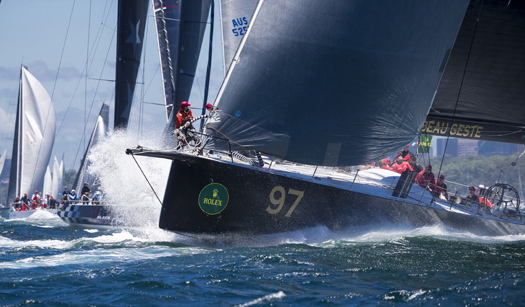
Baptism of fire. The Sydney-Hobart 2013 is Beau Geste's first race – she'd barely been afloat for a month when it started on Thursday. Photo: Rolex/Daniel Forster
Nevertheless, the first time this slightly offbeat boat had a crack at the opposition was in that initial crazy eight minute drag race down Sydney harbour at the start of the race to Hobart on Thursday. Of which more anon. But meanwhile, what's this about an Irish entry disguised as a bog standard Australian one?
Well, they sprang it on us all with perfect timing on Christmas morning. There in the entry list is Breakthrough, a First 40, a boat type always of high interest - when the design was new, back in 2010, two of them took first and second overall in the Rolex Sydney-Hobart Race.
It was a marketing dream for Beneteau, for each race to Hobart will always produce a particular set of conditions which will suit one boat type to a T. In 2010, it was the very new First 40 which hit the spot, coming forward to step into the very big shoes so capably filled for years by the marvellous First 40.7.
They may have got everything right, but circumstances conspired against the new First 40 being a runaway marketing success. Primarily, it was the global recession taking hold big time, particularly in Europe. But then too, there was still plenty of life in the First 40.7, with thriving class associations, and one design racing in events like Cowes Week.
Whatever, we've only seen two First 40s in Irish ownership since the design appeared, one in Baltimore and used for cruising, the other based in the Algarve. But now the good news is that Barry Hurley is actually the skipper of Breakthrough on the race to Hobart. It must be true, as you read it here on Afloat.ie on Christmas morning while talking to that fat white-bearded man in the red suit.....But enough. Even if the official CYCA listing suggests Mathew Vadas is the skipper, man in charge is Barry Hurley, already with two Hobart races notched, and with him he has brought Kenny Rumball, Keith Kiernan and Catherine Halpin, all of the Royal Irish YC, to sail in partnership with the Vadas team, and hoping to repeat that Hurley touch which brought a class win in the Middle Sea Race back in October.
As for the big boat start – well, it was eight minutes like we'd never seen before. Morning clouds had cleared to leave Sydney Harbour at its sparkling best in a brisk sou'easter, reaching start to the first mark, and the biggies went off first at max revs with Wild Oats and Perpetual LOYAL neck and neck for the lead, with Anthony Bell's Perpetual in the weather gauge.

The power of Perpetual LOYAL's hull is plain to see – but that power with its extensive wetted area comes at the expense of light weather performance. Photo: Rolex/Daniel Forster
But the "old" Wild Oats never ceases to surprise, or maybe Mark Richards and his crew know her so well that they can hit top performance while others are still winding up to it. They simply held Perpetual up above the line to the first mark until they were able to peel away for a short run to the turn which left enough of a gap between them and the big black boat to allow Beau Geste to nip in between in second place.
The abiding memory of that eight minute sprint was the way the different boats had sudden bursts of acceleration. You'd to keep reminding yourself that the smallest craft in this flotilla were 70ft Volvos, for all were having speed bursts like dinghies on the plane.
So that was interesting, but then as they started the beat south in open water, it became clear that Wild Oats with a reef in the main was holding on very nicely ahead of the supposedly more powerful Perpetual, while the smaller Beau Geste was sagging to lee. But then, schooners never could point high, whereas Wild Oats' pointing ability in a lumpy sea was a wonder to behold.
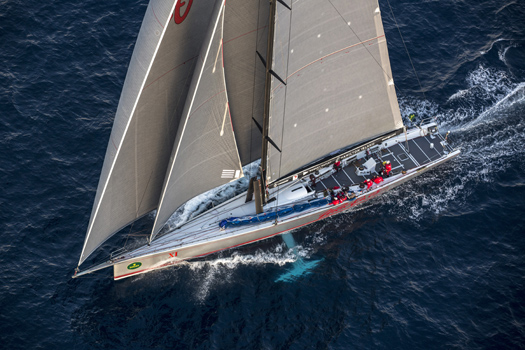
The skinny one....thanks to her slim hull, in the light airs on Day 2 Wild Oats was able to re-take the lead from Perpetual LOYAL. Photo: Rolex/Carlo Borlenghi
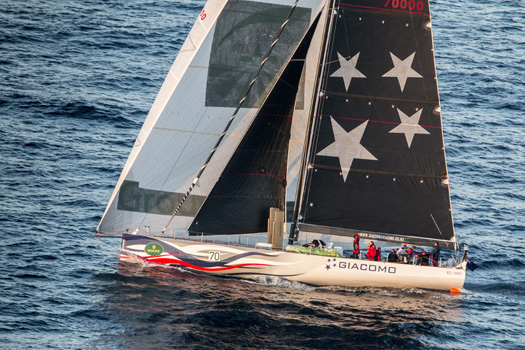
The Volvo 70s may have been developed for big winds in open water, but the former Groupama, now racing for New Zealand as Giacomo, has shown she can hang in when the breezes are light. Photo: Rolex/Carlo Borlenghi
Through the first night, the wind went light, and things were further turned on their head by ace navigator Stan Honey taking Perpetual LOYAL well to the east, which did her a lot of good. By morning they'd worked out an eleven mile lead on Wild Oats, but through the second day of light winds, Wild Oats ground down the big black boat, and as they crossed Bass Strait yesterday evening it was the old dog for the long road, Wild Oats still in the lead and hoping to have the advantage of an afternoon/evening arrival up the Derwent to Hobart before tonight's freshening northerly is replaced by southwest to west winds which could reach gale force, stacking the odds against the little fellows.
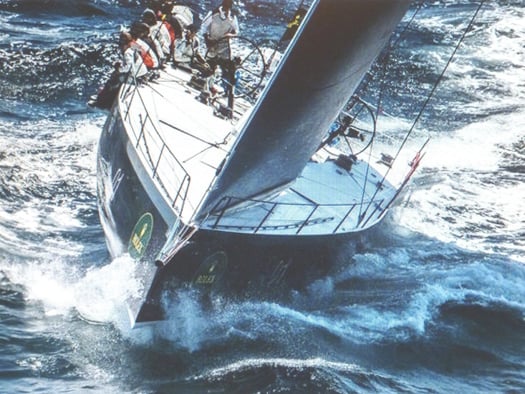
By comparison with some of the boat shapes racing to Hobart, Matt Allen's 60ft Ichi Ban with Gordon Maguire on the helm looks almost traditional. Photo: Rolex/Carlo Borlenghi
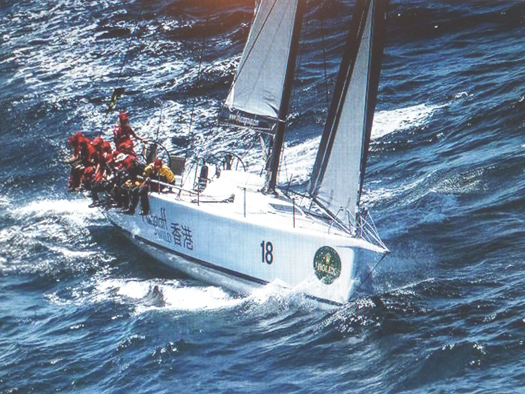
With the renowned Adrienne Cahalan as navigator, the 55ft Wedgetail is in with a shout. Photo: Rolex/Carlo Borlenghi
But meanwhile the top Irish hope, Gordon Maguire with Matt Allen's 60ft Ichi Ban , has been hanging in very nicely and things could fall sweetly their way. That said, while the 60ft Ichi Ban has been staying on the tails of the big boats ahead, not so far astern is the next size group with the lead held by Bill Wild's Reichel Pugh 55 Wedgetail. Formerly Yendys, this is one of Australia's proven all rounders. And for this first race to Hobart under the Wild command, Wedgetail's navigator is Adrienne Cahalan, who is renowned for seeing skippers on to the Hobart podium. But then, she was born in Offaly, and that makes all things possible.
It's Christmas – Time to Race Big Boats to Hobart
The Rolex Sydney-Hobart Race would be a great event at any time. But the annual staging of this 628-mile challenge when much of the Northern Hemisphere is lying low under the effects of mid-winter celebrations provides welcome entertainment and interest for sailors worldwide. The 69th Sydney-Hobart starts next Thursday, December 26th. W M Nixon sets the scene, and highlights Irish interest
Australia is a very large land mass packed tight with valuable metals and minerals of all kinds. With each advance in mining technology, the country's huge natural wealth is more easily accessed, and the general affluence of the relatively small population increases even further.
Thus while much of the rest of the world has been experiencing economic turmoil and recession for the past five years, in Australia it was only a distant rumour. And though the challenge of mining Australia's resources may be a tough business, dominated by some very rough diamonds, all round the coast of this sparsely populated continent there are civilised enclaves of sea-minded folk who live a very agreeable life remote from the harsh realities of industrial mining.
So when they go sailing, they do so in some style in their usually sunny climate. If they compete afloat, it's with all the exuberance of a sports-mad nation with a largely outdoor way of life. And when they compete at the top level, it's increasingly a no-expenses-spared business which leaves much of the rest of the penny-pinching world floundering in their wake.
Australian sailing is on a roll which is really only just getting going. Two of the key people in the three man afterguard of the successful 34th America's Cup defender Oracle back in September were Australia's Jimmy Spithill and Tom Slingsby. The Challenger of Record for the 35th America's Cup is Hamilton Island Yacht Club, sailing headquarters on the island resort located along Australia's Great Barrier Reef. Hamilton Island is one of many pet projects of serial entrepreneur Bob Oatley. And defending champion in the Rolex Sydney-Hobart Race in five days time is the hundred foot Wild Oats XI, owned by the 85-year-old old Oatley, and skippered by Mark Richards.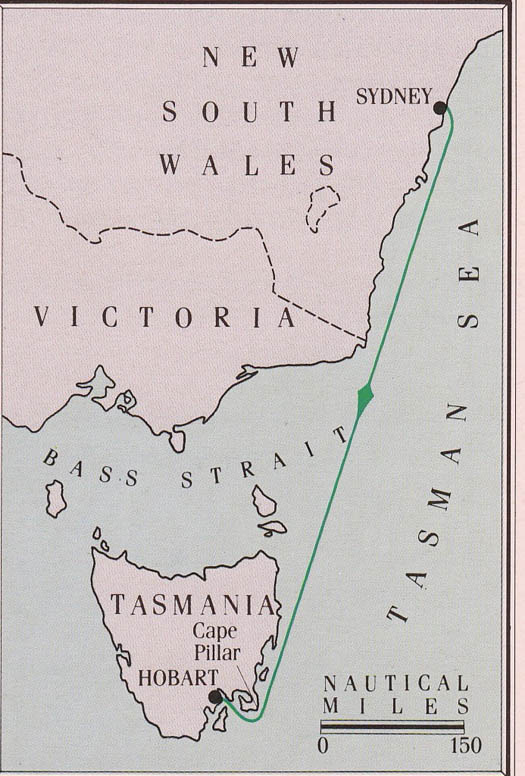
Seen in the context of the Southern Ocean, the Sydney-Hobart course may look relatively sheltered, but it has served up some very rough sailing in its 69 years.
Wild Oats will be defending both the Tattersall's Cup for the handicap win in 2012, and her 2012 course record of 1 day 18 hours 40 minutes and 20 seconds, an average of 14.7 knots. But in the way of Australian sailing these days, those who would topple her provide a formidable lineup. The dark horse in every way is Anthony Bell's 100ft Perpetual LOYAL. With her black hull and black sails, it takes an effort to realise this is Rambler 100 re-born. For when we in Ireland knew this boat back in August 2011, she was very white and very upside-down, having snapped her canting keel at the Fastnet Rock.

Black sails, black hull – Anthony Bell's dark horse Perpetual LOYAL was previously the all-white Rambler 100. She is seen here between Wild Oats XI and the Volvo 70 Giacomo (formerly Groupama) from New Zealand in the Solas Big Boat Challenge in Sydney Harbour on December 10th.
But now this JK design, still reckoned the potentially fastest hundred footer in the world, has had a complete re-vamp by original builders Cookson in New Zealand, and her former existences as Speedboat and then Rambler 100 have been airbrushed out of the picture. She's as good as new or even better, and she's keen to trot, with superstar Tom Slingsby included in her crew to Hobart.
Also competing in the elite hundred foot division is Syd Fischer's Ragamuffin 100. The legendary Fischer is 86, he's doing his 45th Sydney-Hobart, and his boat comes with quite a pedigree. Originally she was the 98ft Maximus, and New Zealand-owned. Some years back, she was in the Solent for Cowes Week under the command of Harold Cudmore. One morning there was a fine north wind, and Cudmore roused out his crew. He reckoned the fresh to strong northerly – a surprisingly rare wind in the Solent – offered the best chance at the Round Isle of Wight record. In those days, round the island record breakers – usually multi-hulls – knew they were in business if they left after breakfast and were back from the 50-mile circuit in time for lunch. The Cudmore-Maximus combo left after breakfast, and were back in time for morning coffee.
Fourth of the flat-out-racing hundred footers is Grant Wharington's Wild Thing, another former 98-footer which woke up one morning to find she'd become a hundred. She's been around the block a bit – it was ten years ago when she took line honours in the Hobart Race – and her skipper is no stranger to sailing controversy. But no-one could accuse him of lacking enthusiasm.
The fifth hundred footer edges towards the cruiser-racer end of the spectrum. German-owned by Gerhard Ruether, and Cyprus-registered, the Bruce Farr-designed Zefiro is fitting in the Hobart Race as part of a world cruise, but the word is that she's a wolf in sheep's clothing, able for 13 knots to windward in heavy weather.
However, with some forecasts suggesting a record-breaking offwind sprint, heavy weather windward ability may well count for little. But in any case, public interest is with the Wild Oats/Perpetual LOYAL contest, as the two boats are distinctly different, with Wild Oats significantly slimmer in beam. She's very much the people's choice, for though today's Australians may be enjoying unprecedented affluence, it's not so long since they were a determinedly self-reliant, can do, and DIY sort of nation.
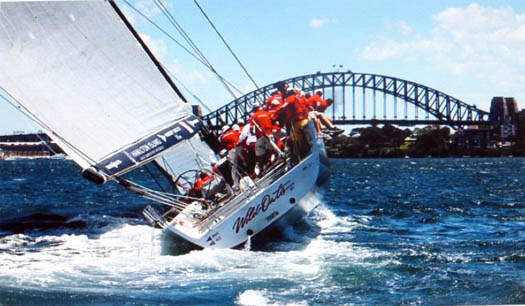
The slim hulled Wild Oats XI powering along towards the Harbour Bridge.
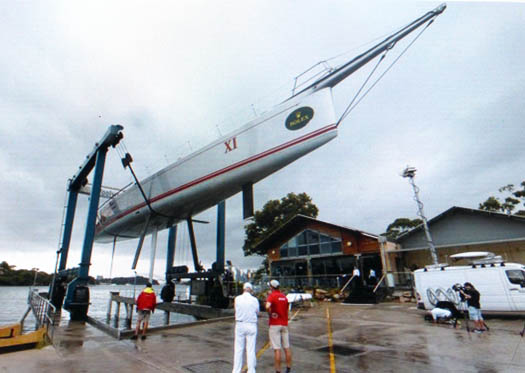
Wild Oats is always Work in Progress. Her crew reckon her latest underwater configuration has all the look of a Swiss army knife.
So the fact that Wild Oats is always Work In Progress, with mods being tried all the time, particularly appeals to the traditional Australian outlook on life, and for 2013's race she is sailing with all sorts of performance-enhancing retractable fins which make her look like a Swiss army knife when she's in the boat hoist.
With Perpetual LOYAL put into action in her new guise only as recently as November, there have been few opportunities to see how the two star biggies perform against each other. The Solas Big Boat Challenge on Sydney Harbour ten days ago was entertaining, but even Sydney's extensive natural harbour doesn't really provide the space for hundred footers to give of their best. In fact, it was Peter Harburg's up-graded Volvo 70 Black Jack (she's the former Telefonica) which led the fleet, hundred footers and all, to the first mark, which shows that she's very much a contender to Hobart.
As for the tussle between Wild Oats and Perpetual LOYAL, it looked fantastic, and Oats had got just ahead again after the more powerful yet slightly lower-rated Perpetual had passed her on the beat. But it ceased to be a tussle when Perpetual shredded a huge gennaker ($170,000 to you, sir) which, as Anthony Bell admitted, was much bigger than they should have been carrying anyway, but that's what happens when you're showing off in harbour.
Not surprisingly, it was the smaller "big boats" which scored best on IRC in the restricted space, with the win being taken by Rob Hanna's TP52 Shogun V by 1 minute and 34 seconds from Matt Allen's new 60ft Ichi Ban. But as Shogun is currently in inshore mode and is not racing to Hobart, the winner among the Hobart contenders was Ichi Ban. And that is all good news in Ireland, as she is helmed by our own Gordon Maguire, Afloat.ie Sailor of the Month for January 2013 after he'd skippered Stephen Ainsworth's 63ft Loki to overall victory in the Australian Offshore Championship.

Gordon Maguire
Everything about Ichi Ban is interesting. Her owner Matt Allen is a pillar of the Australian sailing establishment, as he's a former Commodore of the Hobart race organisers, the Cruising Yacht Club of Australia, and is current President of Yachting Australia. But if that gives you a vision of an elderly alickadoo in a blazer, forget it, the man is a bundle of energy with remarkable international connections. He is much involved with the Premier Composites facility in Dubai where the new boat was built by a team headed by Neil Cox, while the design is by Shaun Carkeek of Cape Town.

Will she be on target? Shaun Carkeek's design for Matt Allen's new 60ft Ichi Ban was aimed at meeting the Sydney-Hobart race's special requirements as averaged over many races
The Ichi Ban team selected a 60-footer, as they reckon that the numbers over the years indicate that's the optimum size for the Hobart race. But as the Solas challenge showed, it also does very nicely for shorter stuff while avoiding the huge expenditure of bigger boats.
There's no lack of bigger craft in the race to Hobart, and here there's further Irish interest, as the eight boats in the Clipper Challenge are involved for the first time, taking on the Rolex Sydney Hobart Race as part of their 17 stage round the world venture, which gets to Derry/Londonderry at the end of June.
It's a stroke of genius on the part of Robin Knox-Johnston and his team, as it puts their Clipper series right into the middle of mainstream sailing. Times was when sailors and sports writers were a bit sniffy about the Clipper project. In fact, one newspaper sports editor dismissed it as a sporting challenge equivalent to racing a fleet of tourist buses filled with paying passengers from Dublin to Killarney.
Personally, I reckon racing tour buses down the Killarney road would be very sporting indeed, but never mind. As it is, with every determined staging of the Clipper Challenge, it has risen in stature. Out in Australia, they think very highly of it indeed, and now with our own Sean McCarter of Lough Swilly YC skippering the home team's boat Derry-Londonderry-Doire (or DLDD for short) interest here is rising all the time.
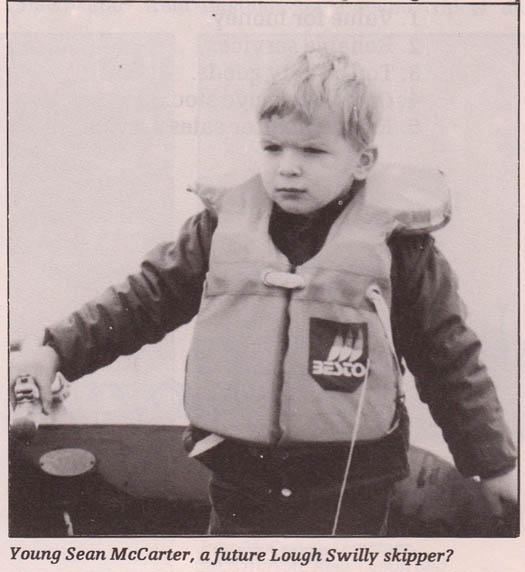
Clipper skipper Sean McCarter as he was aged four, and already at the helm in Lough Swilly in 1984

Sean McCarter in command of Derry-Londonderry-Doire during the current Clipper Race series round the world. Photo: Clodagh Whelan
Sean is 31, but he first featured in the pages of Afloat when he was a very junior helm of four years old in a 1984 feature we did about Lough Swilly. He seems to have been sailing pretty much continuously ever since, and has built up a very loyal crew following among those who have sailed on Derry-Londonderry-Doire, particularly impressing with his capable leadership when, after a knockdown on the very stormy leg from Cape Town to Albany in southwest Australia, they'd to divert to Port Elizabeth in South Africa with injured crewmembers
But then they pressed on for Albany, a port even more appreciated than most when they reached it. It was quite a party, as DLDD's Irish crewmembers include Conor O'Byrne, the Guard who is going all the way round, and Clodagh Whelan of Poolbeg Y & BC, who has rewarded herself with three Clipper ocean stages in celebration of a significant birthday landmark. It's a significant birthday for sure, but the sailing experience has to be quite something to make it special, for since she took up sailing twelve years ago, Clodagh has managed a minimum of a thousand offshore miles every year, including three round Irelands and three Dun Laoghaire-Dingles. Her current berth out of Poolbeg is on Eamon Flanagan's db34 Decibel, but Decibel will have to wait for her crewing services until July 2014, as she will be re-joining DLDD for June's Transatlantic leg to Ireland.
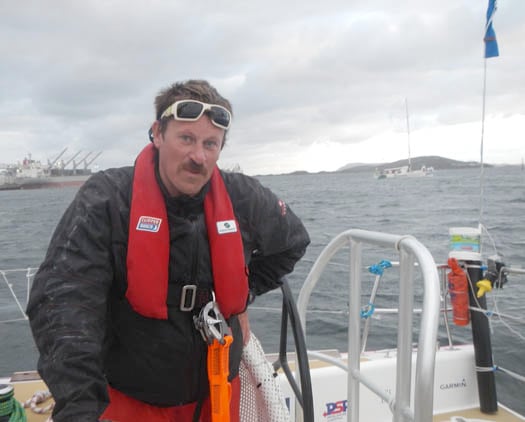
"We're here". Conor O'Byrne tired but very happy as DLDD reaches Albany after the event-filled passage from Cape Town. The moustache was grown for Movember. Photo: Clodagh Whelan

Clodagh Whelan aboard DLDD. In 2013, she fulfilled her personal objective of a minimum of a thousand offshore miles per year several times over.
Meanwhile, like all the other 93 crews from boats large and small racing to Hobart in less than five days time, for those on DLDD it will have to be the quietest Christmas they've ever had, as this can be one very unforgiving experience for anyone who has overindulged. Then too, the challenge of getting out of the harbour and into open water unscathed can be quite enough in itself, as tensions are high and the adrenalin is pumping overtime.
With a fleet of 94 boats and the handicap trophy of the Tattersall's Cup the premier award, in theory it could be anyone's race. But with five days to go, it currently has the look of a big boat's race, as the biggies may get to Hobart with the fair wind all the way. That said, the Solas Challenge showed that racing the big boats up to their optimum level is hugely challenging, whereas the two very potent Volvo 70s Black Jack and Giacomo seem totally manageable by comparison, and astonishingly fast.
And then, just slightly further down the size scale, there's the new Ichi Ban, full of potential, but still new. Extremely new. As Gordon Maguire reported in typically under-stated style on 17th December in an update to the folks back home: ".....we have been super busy, working seven days a week to get the boat ready for Sydney to Hobart. It's coming together very nicely....."
Classic Yachts, Traditional Boats, Where's The Truth?
With a Golden Jubilee Regatta being planned for New Zealand in 2015 to celebrate the glory years of the One Ton Cup from 1965 to 1983, W M Nixon ponders on the requirements for a genuine classic yacht or traditional boat, and makes a plea for saving a very special 12 Metre.
It's said there are enough relics of the True Cross to build a full-size replica of Noah's Ark. You'd need to be very clever with the epoxy saturation techniques to do it, as most of the pieces are very small. But apparently it's reckoned the required volume of timber is out there at shrines throughout the world.
This question of ancient or even vintage authenticity arose as soon as last week's blog about the Peel Traditional Boat Weekend appeared. One commentator, while not prepared to put his head above the parapet even under anonymity in the proper comments section, was quick to point out that not only is it obviously not a weekend as it runs from Wednesday night until Monday, but the three awards winners mentioned were clearly not as they seemed.
The lovely little Menai Straits-based schooner Vilma, while evoking memories of the Welsh slate schooners, is no such thing. She started life as a ketch-rigged Danish fishing boat in 1934. As for the startling bisquine-rigged 50-footer Peel Castle from West Cork, we're in Disneyland. She was originally a motorised Penzance fishing boat built in Porthleven in 1929. But after nine years of patient restoration work completed in the Ilen River in West Cork in 2008, this exotically rigged vessel with her three masts fanning every which way sailed happily to Greece where, one would guess, her rig seemed very much at home.
And as for the "Best in Show" awardee, the 36ft Ainmara, only her hull and deck are as designed and built by John B Kearney in Ringsend in 1912. In Kearney's eleven years of ownership, she set a nuggety little gaff yawl rig with a keel-stepped mainmast only 37ft 6ins in overall length. But these days, she sports a sky-scraping Bermudan rig set on a deck-stepped alloy mast which the owner built himself, and painted brown to look like wood. As for her high-rise coachroof, that was installed in the late 1920s by Harland & Wolff in Belfast, whose speciality was ocean liners, and it shows.
Of the boats whose photos we displayed last weekend, only the little Albert Strange yawl Emerald, the Ramsey longliner Master Frank, the Pilot Cutter Madcap, the cruising cutter Dreva, the Manx nobby White Heather, and the 57ft 1957-vintage offshore racer Drumbeat looked anything like they did originally. The Galway Hooker Naomh Cronan was also of course authentic in appearance, but she was a new build of 15 years ago to the ancient design.
As for the others present in a large and eclectic fleet, many were old boats modified, sometimes very extensively, to provide individualistic vessels suited to the owners' tastes and particular requirements. Being an almost pathological boat modifier myself, I have to confess that my sympathies were largely with these boat changers. Whatever the outcome of their efforts, they were always interesting, and in most cases resulted in a much-improved boat, the success of the modifications being attested to by the very fact that they were at Peel and looking so well they picked up prizes.
But that said, our visit at the beginning of the "weekend" across to the 224-year-old Peggy at Castletown had brought something of an epiphany. She is an object of veneration. There was something extraordinarily moving about seeing and touching the boat which George Quayle had taken across the Irish Sea in 1796 to race successfully against the Windermere yachts. For sure, Quayle changed the Peggy about all the time in her very early years. But the boat we see and sense today is pretty much the boat of 1796, and her conservation planned for 2014 will be watched with special interest.
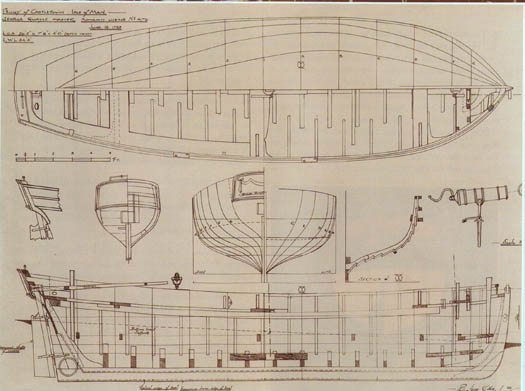
Hull details of the 1789-built Peggy of Castletown. Though the modifications added within three or four years of her building are evident, this is largely the boat which was taken to Windermere in 1796. While the original boat is being conserved during 2014, it is high time somebody in the Isle of Man thought of building a replica to go sailing.
She's of such historical significance that she's definitely not for sailing again. But as she has had her lines taken off and her construction details annotated, it strikes me that it's high time somebody in the Isle of Man built a replica to take out sailing. It would certainly add something very special to the Peel Weekend, a matter of entertainment and interest rather than obscure arguments about authenticity. But as the classic boat movement continues to gather pace, the arguments about what is or is not a genuine classic grow with it, and the heat of the argument has nothing to do with the size of the boats involved.
Thus at the delightful little port of Bosham in Chichester Harbour down in West Sussex, passions have been aroused at what is now the premier vintage and classic dinghy regatta, the Bosham Revival. The Portsmouth Yardstick handicap system is allegedly being exploited by some boats in the 14ft Merlin Rocket class, a vintage developmental design where boats which are effectively new build are being passed off as originals to the historic Jack Holt Passing Cloud design. This is being done on the basis of including an ancient thwart or knee from an otherwise totally decayed original.
Such an approach has been an embarrassing part of the classic yacht restoration movement from the start. By contrast, we are all aware of the painstaking care Hal Sisk and his team went to in restoring the 1894 Watson cutter Peggy Bawn, treading carefully on the lines between restoration, re-build and new build. As for conservation, if you claim you've conserved an historic boat, then it's a museum piece, and won't sail again.
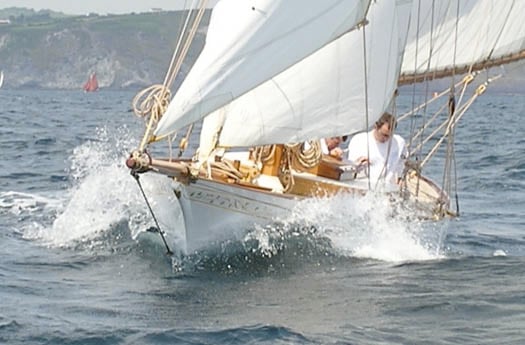
Absolutely oozing authenticity.......the restoration of the 1894 Watson cutter Peggy Bawn by Hal Sisk and his team provides a global benchmark. She is seen here at Glandore Classic Regatta.
But of course, in revitalising significant and almost derelict old boats, the desire to sail them again is probably the prime motivation. And as for what qualifies as a classic and authentic under some old measurement rule, we're likely to see yet another wave of debate with the news that the great Chris Bouzaid and a team in the Royal New Zealand YS plan to celebrate the Golden Jubilee of the One Ton Cup's best era in New Zealand in 2015.
As mentioned here in a recent blog, the One Ton Cup was originally presented in 1898 by the Earl of Granard (later the Commodore of the National YC in Dun Laoghaire in the 1930s) for international racing in France between boats rating One Ton under a French measurement rule. It later lay dormant for a long time, but then in 1965 it was revived for RORC level rating competition for boats around 36ft LOA in an instantly successful series at Le Havre.
That was won by the Sparkman & Stephens-designed Diana from Denmark, a classic S & S offshore racer of the time, with rudder attached to the trailing edge of the keel. But 1965 was also the year in which a young American, Dick Carter, won the Fastnet with his own-designed 33ft Rabbit, steel built with separate spade rudder. So for the 1966 One Ton Worlds in Denmark, Carter turned up with the new steel 37ft Tina, beautifully built by the Maas Brothers in Breskens for Ted Stettinius, and they won the One Ton Cup from an exceptionally competitive international fleet.
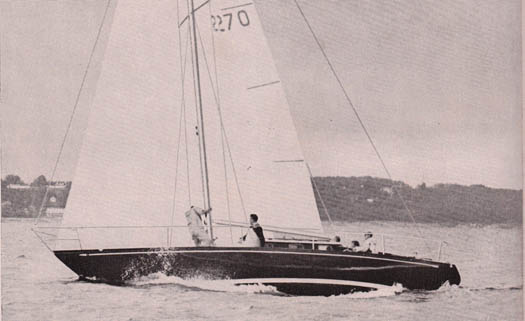
The quality of the steelwork in Tina's hull is evident as she heads for victory in the 1966 One Ton Worlds.
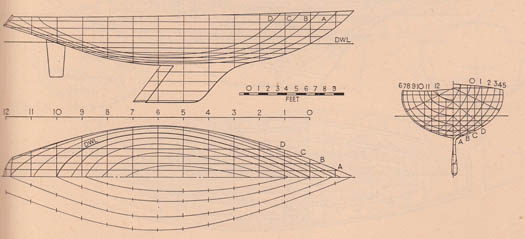
The hull lines of Tina reflected Dick Carter's enthusiasm for the sections of the boats built to classic Scandinavian Square Metre Rules such as the 30 Square Metre. Steel was used to build the hull as Carter reckoned it conferred a rating advantage under the RORC rule, but it also enabled the skilled Maas Brothers builders to create an extraordinarily slim keel which was still sweetly faired at the garboards.

Dick Carter was the first to discern just how much rating advantage could be obtained by a large foretriangle under the RORC Rule in the mid-1960s, and as a result Tina's sailplan looks very odd today.
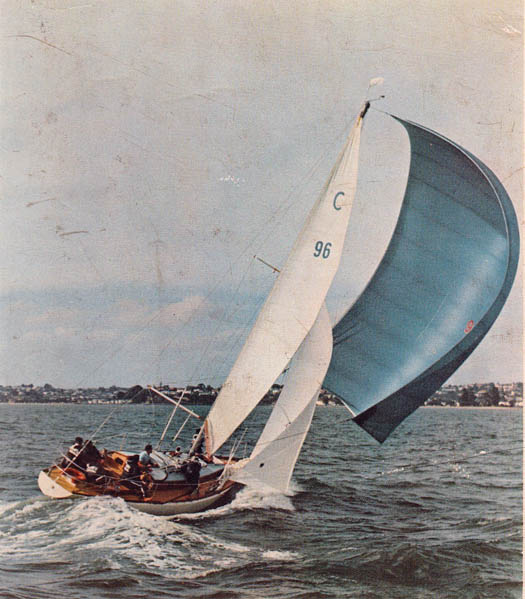
Chris Bouzaid's S & S design Rainbow from New Zealand won the One Ton Worlds in 1969 - and she also won the Sydney-Hobart Race.
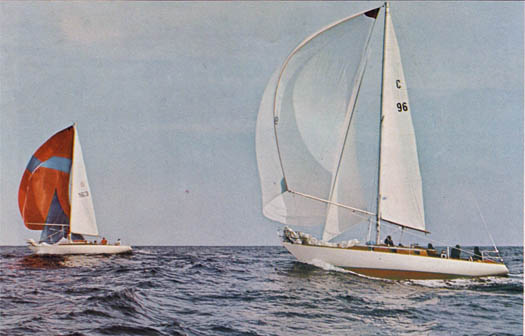
The moment of truth in the final race – an offshore event – in the 1969 One Ton Worlds. Although Carter-designed boats were supposed to be better off the wind, while S & S designs excelled to windward, in the final miles running to the finish of the concluding offshore race Rainbow (right) wore down the defending German champion, the Carter-designed Tina-derived Optimist, and snatched the lead to take the One Ton Cup back to Auckland.
Carter designs won again in 1967 and 1968, but in 1969 with the racing from Heligoland in the midst of the North Sea, it was the very dedicated crew of the Bouzaid team from New Zealand with the Sparkman & Stephens-designed Rainbow who took the trophy. After that, the One Ton Cup had a dozen glorious years, typical being 1974 when the whole world focussed on the racing between Hugh Coveney's Ron Holland-designed Golden Apple from Cork and Jeremy Rogers' Doug Peterson-designed Gumboots from England, with Gumboots taking the win by a hairsbreadth.
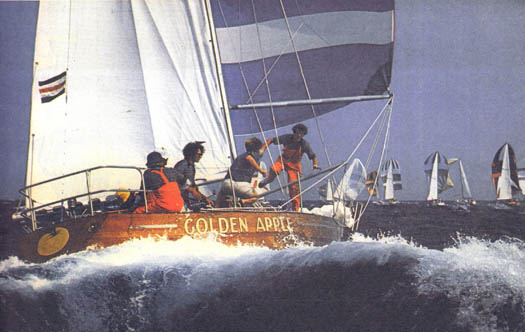
This would be another gold standard participant in the One Ton Golden Jubilee Regatta in New Zealand in 2015. The 1974 Ron Holland-designed Golden Apple, owned by Hugh Coveney and built in Cork by Killian Bushe with Harold Cudmore as skipper, almost won the One Ton Cup, and was one of world sailing's superstars in the mid-70s. Photo: Courtesy RCYC
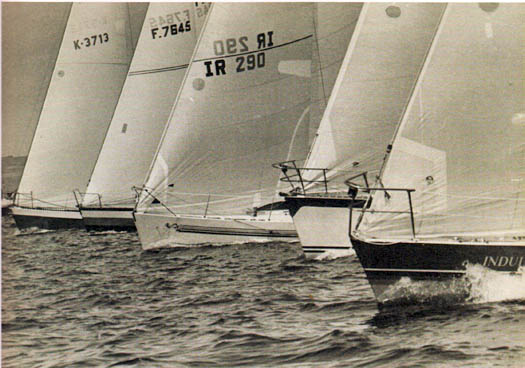
When Ireland finally won.....close-packed start at the One Ton Worlds at Cork in 1981, when the NYC's Frank Woods entered the Castro-designed Justine III (IR 290) with Harold Cudmore as skipper. In this challenging set-up, the positioning of Justine is a joy to behold. Photo courtesy RCYC
Golden Apple's main sailor had been Harold Cudmore, and after he'd won the Half Ton Cup in 1976, the One Ton Cup finally became his when he skippered the NYC's Frank Woods' Castro-designed Justine III to victory in the 1981 series at Cork. But in 1984 with the RORC Rule being replaced by the IOR, One Ton cuppers around 36ft became history, so the suggestion from New Zealand is that the Golden Jubilee Regatta should be restricted to the absolute classics created by the RORC Rule between 1965 and 1983.
Heaven knows there are enough of them about, but for most folk thirty years ago is a very long time, so fifty must seem like eternity. This is something which struck me a few years back up in Killbegs in Donegal when I was trying to get an arty photo, framed by the bows of super-trawlers, of a white boat lying to a mooring in sunshine. She looked like a Dick Carter boat, and when a little puff of wind swung her stern to, the name on the transom showed this wasn't just any old Dick Carter boat. This was Tina.
Quite what she was doing in Donegal I don't know, though I believe her owner lived in that mountainous county. But I haven't seen her there during the past few years, even though the local yacht fleet is increasing, with Killybegs due to get a 65-boat marina, while Killybegs Sailing Club is an important part of the northwest triumvirate of Killybegs SC, Mullaghmore SC, and Sligo YC.
So it's now a long way indeed from the old days when that late great Killybegs fishing skipper James MacLeod was so keen on the sea that in his time off fishing he nipped down to Rosses Point to race his GP 14 with the Sligo fleet. Now there was a man, and no mistake.
This morning, however, the current whereabouts of Tina have added interest with the news of the One Ton Golden Jubilee in New Zealand in 2015. Having seen the interest which the Half Ton Classics have engendered, we can guess at some of the boats which will emerge in order to be eligible for the One Ton Classics in 2015. But in such a line-up, the steel-built Tina of 1966 would be Gold Standard.
With classics restoration, you need a balance between love of old boats, and a can-do ability. Obviously you also need lots of money, but that could be disastrous in itself, as the spirit of the boat has to be preserved. Many rich people automatically think new is best, and in purely functional terms it is certainly much better value, but with classic boats and yachts, you're into strange territory.
A case in point is to be found on the shores of Chichester Harbour, where the mortal remains of the 12 Metre Flica are to be found in a shed beside the marina at Birdham Pool, which is itself a place of historical fascination, as it was the first yacht harbour to be created in a pool which backed up an old tide mill.
Flica was the big boat around Cork Harbour in the 1950s. Owned by a man of style, Aylmer Hall, she exuded all the style of a classic which had been designed by the great Charles E Nicholson in 1928, working in conjunction with the tank and wind-tunnel research team of the owner, aviation magnate Richard Fairey.
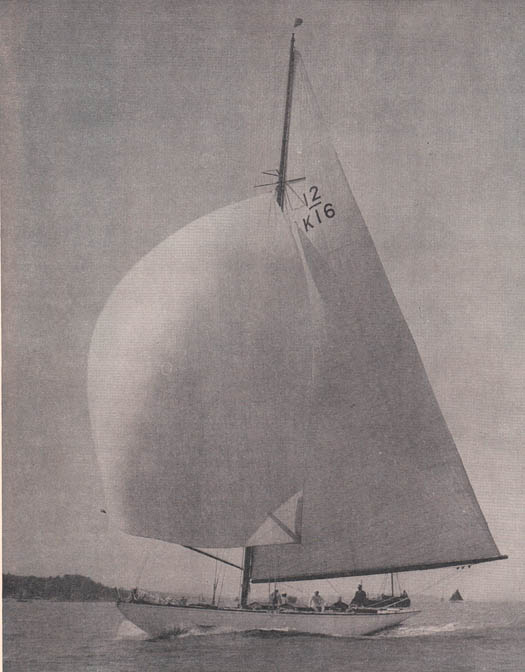
During the period 1928-1938. Flica was the most successful 12 Metre of all in the Solent. She is seen here off Cowes under the ownership of Hugh Goodson in 1936.
In terms of longevity at the sharp end of the 12 Metre fleet, Flica was only to be rivalled by the Sparkman & Stephens designed Vim which appeared in 1939, but as World War II interrupted international racing for the Twelves, it was Flica which had the longest run of success, and she was reckoned as the boat to beat for much of the 1930s when she was owned by Hugh Goodson.
The 12 Metres of that era – boats around 66ft in overall length – were wellnigh perfect, being elegant of appearance, manageable in size, and yet large enough to be impressive. Thus it was a stroke of genius by Aylmer Hall to acquire Flica in 1950 when life in Ireland was becoming decidedly dull and small-minded, for Flica was none of these things. To add greatly to gaiety of the nation and life's rich tableau, she even managed to be spectacularly dismasted during the Cobh People's regatta of 1957, fortunately without anyone being seriously injured, but they talked of little else around Cork Harbour for years.
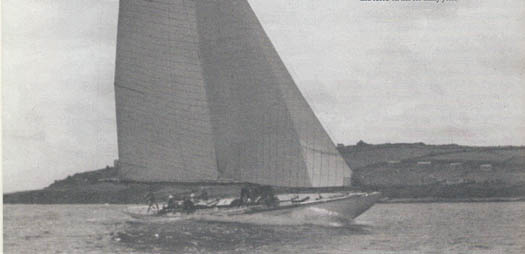
When Aylmer Hall brought Flica to Cork Harbour in 1950, he introduced much-needed style when there was little enough of it about in Ireland. Photo courtesy RCYC
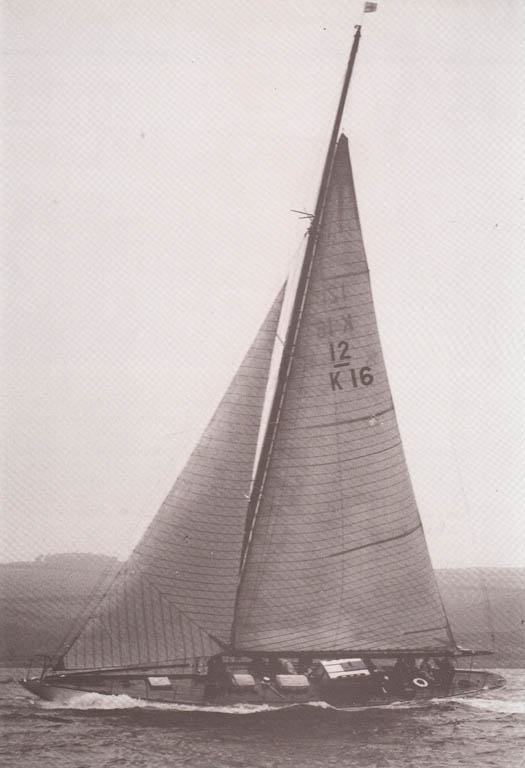
Flica storming seaward from Cork Harbour on a less-than-summery day. At such times, people wondered what it would be like if her mast broke. At Cobh People's Regatta in 1957, they got their answer, but fortunately nobody was seriously injured.
Quite how this supreme classic is now mouldering in the shed at Birdham I don't know, and perhaps I'd rather not know, as it must be a great sadness for someone. I first happened upon her in 2012, and already it looked as though restoration had long since ground to a halt. In late September this year, there was little or no change, only more dust, so much so that the locals must see her now as part of the scenery, an inexplicable bit of background which is simply accepted.

Flica as she was in late September 2013, awaiting a restoration which seems to have ground to a halt. Photo: W M Nixon

Flica is now a long way from the Solent champion of the 1930s, and the Queen of Cork Harbour in the 1950s. Photo: W M Nixon
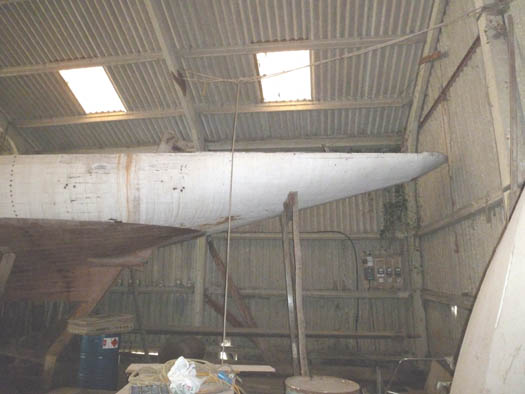
Her counter stern seems more beautiful than ever – this was Charles E Nicholson on top of his form Photo: W M Nixon
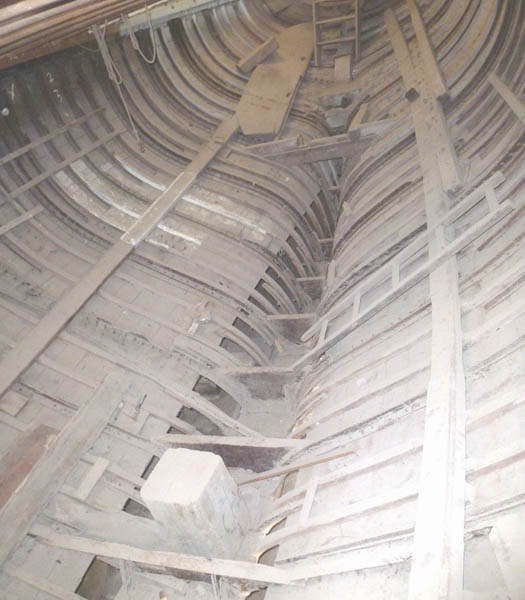
The empty interior, looking aft. The accumulation of dust suggests this restoration has long since ground to a halt. Photo: W M Nixon
Seeing a significant boat merely as unremarkable background is something which can happen to all of us. Back in 1996, we cruised to St Malo in order to see the first yacht built by James Kelly of Portrush. Built in 1897 for Belfast-based cruising pioneer Howard Sinclair, who designed the boat himself, the 40ft Nuada had originally been called Saiph. But Sinclair acquired a taste for having new boats built, so after a year he designed and had James Kelly build a 15-tonner called Yucca (his boat names were just horrible), and Saiph became Nuada in Scottish ownership, and in time a distinguished part of the Clyde Cruising Club fleet for many years.
Somehow or other she found her way to France, and we'd got to hear about her in the ownership of Bernard Julienne of St Malo, so this provided a good excuse to cruise to that wonderful port. We even took along a bottle of Bushmills whiskey to present to Bernard, as it's distilled just six miles from where Nuada had been built, in a little boatyard where James Kelly subsequently built many yachts, including three boats of the Dublin Bay 21 Class, and seven Howth/Dublin Bay 17s.
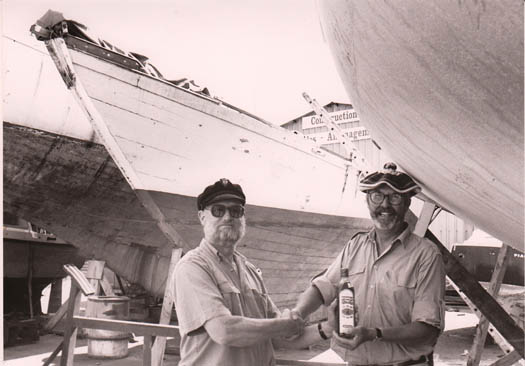
And no, it's not a Convocation of Silly Sailing Hats. In St Malo in 1996 beside the bow of the 40ft Nuada, which was built in Portrush in 1897, Ed Wheeler of the Irish Cruising Club presents a bottle of Bushmills whiskey (distilled just six miles from Nuada's birthplace) to Bernard Julienne, owner of the boat. Photo: W M Nixon
Nuada was in mid-restoration, or rather what people hope is mid-restoration with all the interior stripped out and everything cleared for action. In reality, you're about a tenth of the way there. So naturally much of our interest was in this massive work project, the prospect of which was overpowering. We clowned about a bit with the Bushmills presentation and took our leave, for as it was lunchtime, and this was France, there was nobody around to ask about the boat next door, which was also in a sorry state. She was much bigger than Nuada, and looked really interesting. She was called Pinta.
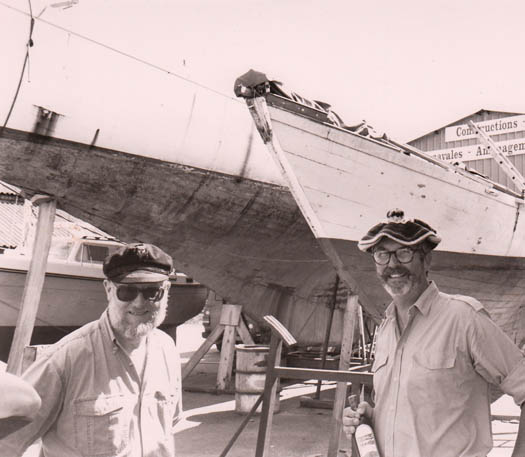 It was only in the post formal clowning around that we got a photo which showed anything of the boat next to Nuada. And it was only later that we discovered she was originally Vanity V from 1936, the last 12 Metre designed and built by Fife of Fairlie. Photo: W M Nixon
It was only in the post formal clowning around that we got a photo which showed anything of the boat next to Nuada. And it was only later that we discovered she was originally Vanity V from 1936, the last 12 Metre designed and built by Fife of Fairlie. Photo: W M Nixon
Some time later we discovered Pinta was originally Vanity V of 1936, the last 12 Metre to be designed and built by Fifes of Fairlie. Like it or not, there's a pecking order in classics. We may have originally gone to St Malo to see the first yacht built by James Kelly. But the fact that we'd been right beside the last and greatest 12 Metre from the Fife stable has become the dominant memory of our time there. Cruel as it was, the restoration or otherwise of Nuada became something very far down the line from a new interest in whether or not Vanity V ever got restored.
Happily, she did. Vanity V has since become an adornment of the Baltic classic yacht scene. Wouldn't you just love to do something similar for Flica?




































